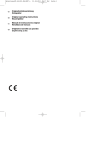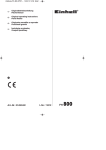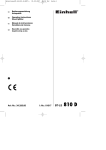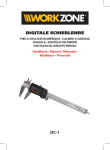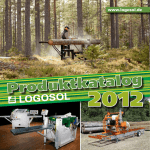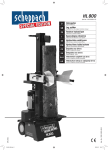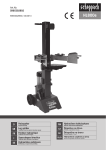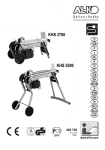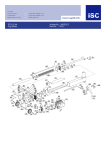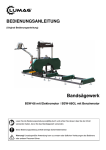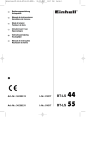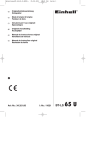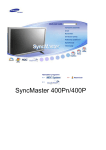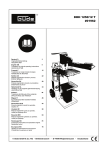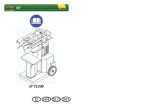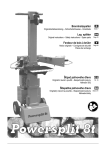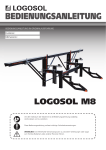Download Nr.: 11010 BT
Transcript
Anleitung_BT_LS_810_DB_SPK7:_ 01.04.2011 Originalbetriebsanleitung Holzspalter t Original operating instructions Wood Splitter m Manual de instrucciones original Hendidora de troncos X Originalna navodila za uporabo Cepilni stroj za les 8:17 Uhr Seite 1 � Art.-Nr.: 34.320.65 I.-Nr.: 11010 BT-LS 810 DB Anleitung_BT_LS_810_DB_SPK7:_ 01.04.2011 8:18 Uhr Seite 2 1 1 10 19 19 11 8 22 22 4 3 4 2 9 5 7 6 2 22 14 11 2 23 24 26 20 25 12 7 5 15 17 3 19 21 13 2 16 4 28 10 Anleitung_BT_LS_810_DB_SPK7:_ 01.04.2011 8:18 Uhr 3 4 5 6 Seite 3 16 7 8 16 15 14 7 3 Anleitung_BT_LS_810_DB_SPK7:_ 9 01.04.2011 8:18 Uhr 10 16 7 15 11a 11b 12 13 4 Seite 4 Anleitung_BT_LS_810_DB_SPK7:_ 14a 01.04.2011 8:18 Uhr Seite 5 14b 22 23 24 26 25 14c 14d 19 26 25 24 23 19 22 22 19 19 20 22 15a 15b A B C 5 Anleitung_BT_LS_810_DB_SPK7:_ 16 01.04.2011 8:18 Uhr Seite 6 17 C A 11 18 19 20 21 6 B Anleitung_BT_LS_810_DB_SPK7:_ 22 01.04.2011 8:18 Uhr Seite 7 23 A B C 24 25 26 27a 7 Anleitung_BT_LS_810_DB_SPK7:_ 01.04.2011 27b 8:18 Uhr 27c 27 28 8 27 29 B 30 Seite 8 A 31 Anleitung_BT_LS_810_DB_SPK7:_ 32 01.04.2011 8:18 Uhr Seite 9 33 18 A 34 18 35a A B 35b 36 C 9 Anleitung_BT_LS_810_DB_SPK7:_ 01.04.2011 37 Seite 10 38 H 39 8:18 Uhr A L 40 A 10 Anleitung_BT_LS_810_DB_SPK7:_ 01.04.2011 8:19 Uhr Seite 11 D Inhaltsverzeichnis 1. 2. 3. 4. 5. 6. 7. 8. 9. Sicherheitshinweise Gerätebeschreibung und Lieferumfang Bestimmungsgemäße Verwendung Technische Daten Vor Inbetriebnahme Bedienung Reinigung, Wartung und Ersatzteilbestellung Entsorgung und Wiederverwertung Fehlersuche 11 Anleitung_BT_LS_810_DB_SPK7:_ 01.04.2011 8:19 Uhr Seite 12 D Achtung! Beim Benutzen von Geräten müssen einige Sicherheitsvorkehrungen eingehalten werden, um Verletzungen und Schäden zu verhindern. Lesen Sie diese Bedienungsanleitung deshalb sorgfältig durch. Bewahren Sie diese gut auf, damit Ihnen die Informationen jederzeit zur Verfügung stehen. Falls Sie das Gerät an andere Personen übergeben sollten, händigen Sie diese Bedienungsanleitung bitte mit aus. Wir übernehmen keine Haftung für Unfälle oder Schäden, die durch Nichtbeachten dieser Anleitung und den Sicherheitshinweisen entstehen. 1. Sicherheitshinweise Die entsprechenden Sicherheitshinweise finden Sie im beiliegenden Heftchen! WARNUNG Lesen Sie alle Sicherheitshinweise und Anweisungen. Versäumnisse bei der Einhaltung der Sicherheitshinweise und Anweisungen können elektrischen Schlag, Brand und/oder schwere Verletzungen verursachen zur Folge haben. Bewahren Sie alle Sicherheitshinweise und Anweisungen für die Zukunft auf. 21. Klettverschluss (Transportsicherung Betätigungshebel) 22. 2x Sicherheitsbügel 23. 4x Schrauben für Sicherheitsbügel 24. 6x Beilagscheiben für Sicherheitsbügel 25. 6x Sicherungsringe für Sicherheitsbügel 26. 6x Muttern für Sicherheitsbügel 27. Befestigungspunkte 28. 2x Stahldübel 2.2 Lieferumfang Öffnen Sie die Verpackung und nehmen Sie das Gerät vorsichtig aus der Verpackung. Entfernen Sie das Verpackungsmaterial sowie Verpackungs-/ und Transportsicherungen (falls vorhanden). Überprüfen Sie, ob der Lieferumfang vollständig ist. Kontrollieren Sie das Gerät und die Zubehörteile auf Transportschäden. Bewahren Sie die Verpackung nach Möglichkeit bis zum Ablauf der Garantiezeit auf. ACHTUNG Gerät und Verpackungsmaterial sind kein Kinderspielzeug! Kinder dürfen nicht mit Kunststoffbeuteln, Folien und Kleinteilen spielen! Es besteht Verschluckungs- und Erstickungsgefahr! 2. Gerätebeschreibung und Lieferumfang (Bild 1-40) Originalbetriebsanleitung Sicherheitshinweise 3. Bestimmungsgemäße Verwendung 2.1 Gerätebeschreibung 1. Spaltkeil 2. Stammauflage 3. 2x Handschutzbleche 4. Betätigungshebel 5. Stammauflagehalter 6. Standfuß 7. 2x Räder 8. Schalter- /Steckerkombination 9. Motor 10. Transportgriff 11. 2x Stammhaltebleche mit Befestigungsschrauben und Sternmuttern 12. Kette zum Einstellen der Spaltkeilhöhe 13. 4x Schrauben für Schalter-/Steckerkombination 14. Radachse 15. 2x Beilagscheiben für Radachse 16. 2x Sicherungssplinte für Radachse 17. Kettenhaken 18. Öleinfüllschraube 19. 2x Schutzblech 20. 2x Schraube für Schutzblech 12 Der Holzspalter ist zum Spalten von Holz mit maximalen Längen von 520/770/1040 mm und einem Durchmesser von max. 400 mm ausgelegt. Der Stammdurchmesser ist lediglich ein Hinweis. Dünnes Holz kann schwer zu spalten sein, falls es Astlöcher enthält oder die Fasern sehr stark sind. Ein dickeres Holz kann auch gespalten werden, wenn seine Fasern glatt und locker sind. Die Maschine darf nur nach ihrer Bestimmung verwendet werden. Jede weitere darüber hinausgehende Verwendung ist nicht bestimmungsgemäß. Für daraus hervorgerufene Schäden oder Verletzungen aller Art haftet der Benutzer/Bediener und nicht der Hersteller. Bitte beachten Sie, dass unsere Geräte bestimmungsgemäß nicht für den gewerblichen, handwerklichen oder industriellen Einsatz konstruiert wurden. Wir übernehmen keine Gewährleistung, wenn das Anleitung_BT_LS_810_DB_SPK7:_ 01.04.2011 8:19 Uhr Seite 13 D Gerät in Gewerbe-, Handwerks- oder Industriebetrieben sowie bei gleichzusetzenden Tätigkeiten eingesetzt wird. 4. Technische Daten Netzspannung: Aufnahmeleistung: Leerlaufdrehzahl: Schutzart: Spaltkraft max: Spalthub: Spaltgeschwindigkeit Abwärts: Aufwärts: Stammaufnahmekapazität: Durchmesser: Länge: Ölmenge: Gewicht: Schalldruckpegel LpA Unsicherheit KpA Schallleistungspegel LWA Schwingungsemissionswert ahw 400 V 3~ 50 Hz 3600 W S2 15 min 2950 min-1 IP 54 8t 480 mm 0,032 m/s 0,12 m/s 50-400 mm 100-1040 mm 4l 105 kg 87 dB(A) 3 dB 100 dB(A) < 2,5 m/s2 Einschaltdauer: Die Einschaltdauer S2 15 min (Kurzzeitbetrieb) sagt aus, dass der Motor mit der Nennleistung 3600 Watt nur für die auf dem Datenschild angegebene Zeit (15 min) dauernd belastet werden darf. Andernfalls würde er sich unzulässig erwärmen. Während der Pause kühlt sich der Motor wieder auf seine Ausgangstemperatur ab. 5. Vor Inbetriebnahme 5.1 Montage der Schalter-/Steckerkombination (Abb. 3) Montieren Sie die Schalter-/Steckerkombination wie in Abbildung 3 gezeigt am Holzspalter. Verwenden Sie hierfür die 4 Schrauben (Abb. 2/Pos. 13). 5.2 Montage des Transportgriffes (Abb. 4/5) Entfernen Sie mit einem Inbusschlüssel die beiden Schrauben im Transportgriff (Abb. 4). Führen Sie den Transportgriff über die beiden Löcher an der rückseitigen Abdeckung des Holzspalters und schrauben Sie ihn mit den beiden Schrauben wie in Abbildung 5 gezeigt fest. 5.3 Montage der Räder (Abb. 6-10) Stecken Sie einen Sicherungssplint (Abb. 2/Pos. 16) durch eines der Löcher in der Radachse (Abb. 2/Pos.14) und biegen Sie ihn wie in Abbildung 6 gezeigt um. Schieben Sie nun eine Beilagscheibe (Abb.2/Pos. 15) und ein Rad (Abb. 2/Pos. 7) über diese (Abb. 7). Führen Sie die Radachse durch die dafür vorgesehenen Löcher unten an der Rückseite des Holzspalters (Abb. 8). Stecken Sie nun das verbliebene Rad und die Beilagscheibe auf die Radachse (Abb. 9) und sichern Sie diese mit dem übrigen Splint (Abb. 10). 5.4 Montage der Betätigungshebel und Handschutzbleche (Abb. 11a-14) Entfernen Sie bei beiden Handschutzblechen die bereits vormontierten Befestigungsschrauben indem Sie wie in Abbildung 11a die Muttern lösen und die Schrauben herausziehen. Führen Sie die Handschutzbleche samt Betätigungshebel wie in Abbildung 11b gezeigt von vorne in den Holzspalter, so dass die Enden der Betätigungshebel durch die dafür vorgesehenen Aussparungen im Betätigungsgestänge ragen (Abb. 12). Verschrauben Sie die Handschutzbleche dann mit den vorher demontierten Befestigungsschrauben wie in Abbildung 13 – 14a gezeigt. Handschutzbügel (Pos.22) und Schutzbleche (Pos.19) werden an den Handschutzblechen (Pos.3) wie auf Abb. 14b-14d zu sehen montiert. 5.5 Montage der Stammhaltebleche (Abb. 15a-18) Lösen Sie bei beiden Stammhalteblechen (Abb. 2/Pos. 11) die Sternmutter, wie in Abbildung 15a zu sehen, indem Sie diese gegen den Uhrzeigersinn drehen. Jetzt erhalten Sie das Stammhalteblech, die Sternmutter A, die Beilagscheibe B und die Befestigungsschraube C (Abb 15b). Schieben Sie die Stammhaltebleche durch die Führungsschlitze in den Handschutzblechen, wie in Abbildung 16 gezeigt. Achten Sie dabei darauf, dass die Langlöcher in den Stammhalteblechen deckungsgleich mit den Befestigungslöchern sind. Stecken Sie wie in Abbildung 17 gezeigt die Befestigungsschrauben A von unten durch die Langlöcher der Stammhaltebleche und die Löcher der Handschutzblechen und sichern Sie diese, indem Sie sie mit den Beilagscheiben B und den Sternmuttern C von oben verschrauben (Abb. 18). Mit Hilfe der Langlöcher können die Stammhaltebleche entsprechend den Stammdicken justiert werden. 13 Anleitung_BT_LS_810_DB_SPK7:_ 01.04.2011 8:19 Uhr Seite 14 D 5.6 Montage der Kette zum Einstellen der Spaltkeilhöhe (Abb. 19-21) Lösen Sie zuerst die Kontermutter vom Kettenhaken (Abb. 19). Verschrauben Sie den Kettenhaken wie in Abbildung 20 gezeigt am dafür vorgesehenen Loch neben der Kettenhalterung hinter dem Spaltkeil. Die Kette dient zum Begrenzen der Höhe des Spaltkeils. Hierzu den Spaltkeil ca. an die gewünschte Position fahren, das Gerät ausschalten (Abb. 29) und die Kette entsprechend einhängen (Abb. 21). 5.7 Montage der Stammauflage (Abb. 22-26) Die Stammauflage kann in 3 unterschiedlichen Höhen montiert werden (Abb. 22): Position A: max. Scheitlänge 520 mm Position B: max. Scheitlänge 770 mm Position C: max. Scheitlänge 1040 mm Hierfür sind 3 Aufhängevorrichtungen in unterschiedlichen Höhen am Holzspalter montiert. Um die Stammauflage einzusetzen müssen zuerst die Arretierhebel der entsprechenden Aufhängevorrichtung nach oben geklappt werden (Abb. 23), so dass diese senkrecht stehen (Abb. 24). Daraufhin wird die Stammauflage von vorne in die Aufhängevorrichtung geschoben (Abb. 25) und durch Umlegen der Arretierhebel gesichert (Abb. 26). 5.8 Hydrauliköl einfüllen: Der Holzspalter muss vor der ersten Inbetriebnahme mit Öl befüllt werden. Lesen Sie hierzu den Abschnitt 7.3.2 „Wechseln des Hydrauliköls“ Achtung! Überprüfen Sie, ob sich der Motor in die am Motorgehäuse (Abb. 1/Pos. 9) eingeprägte Drehrichtung dreht. Ist das nicht der Fall, schalten Sie das Gerät sofort aus und ändern Sie die Drehrichtung durch eine 180°-Drehung des Phasenwenders (Abb. 40/Pos. A). Führen Sie anschließend eine erneute Überprüfung durch. 6.4 Spalter sicher aufstellen. Der Holzspalter darf nur auf ebenem Boden aufgestellt werden. Um eine hohe Standfestigkeit zu gewährleisten ist es notwendig den Holzspalter mit den beiden Stahldübeln (Pos. 28) am Betonboden zu verschrauben. Wählen Sie einen Standort an dem Sie den Holspalter dauerhaft betreiben können. Stellen Sie den Holzspalter an die gewünschte Stelle, markieren Sie die Bohrlöcher. Zur sicheren Verankerung der Stahldübel bohren Sie je Befestigungspunkt (Abb. 27b und 27c/ Pos.27) ein Loch mit einem Durchmesser von 12mm und einer Tiefe von 60mm in den Betonboden. Schieben Sie die Stahldübel in die gebohrten Löcher, positionieren Sie den Holzspalter und verschrauben Sie diesen mit dem Boden. Der Holzspalter darf nur in Bodenhöhe betrieben werden. Es darf kein Material unter den Holzspalter gelegt werden um die Höhe des Geräts zu verändern oder um zu versuchen die Standfestigkeit zu erhöhen. Sollte der Holzspalter schief und/oder wackelig stehen muss er an einem anderen Standort aufgestellt werden. Ein Betrieb auf weichen Untergründen wie Rasen oder Kies ist nicht erlaubt, da das Gerät während des Betriebes einsinken bzw. kippen könnte. 6. Bedienung 6.1 Planen Sie Ihre Arbeitsumgebung. Arbeiten Sie sicher und sparen Sie Mühe, indem Sie zuerst Ihre Arbeitsumgebung planen. Positionieren Sie Ihre Stämme dort, wo sie leicht zu erreichen sind. Legen Sie einen Platz zum Stapeln des Spaltholzes fest oder laden Sie es auf einen danebenstehenden Lastkarren oder einen anderen Träger/ Karren. 6.2 Die Stämme zum Spalten vorbereiten. Dieser Spalter nimmt Stämme auf, deren Länge max. 1040 mm und Durchmesser max. 320 mm sind. Nicht versuchen grüne Stämme zu spalten. Trockene, gelagerte Stämme spalten sich viel leichter und werden sich nicht so oft verklemmen wie grünes (nasses) Holz. 6.3 Verlegen Sie die Netzleitung. Legen Sie eine geeignete Steckdose an, falls notwendig auch eine geeignete Verlängerungsleitung. 14 6.5 Entlüften. Die Entlüftungsschraube (Abb.33/Pos. A) muss im Betrieb immer gelockert sein, um die einwandfreie Funktion des Gerätes sicherzustellen. Lösen Sie die Entlüftungsschraube vor jeder Inbetriebnahme um ca. 5 Umdrehungen und ziehen Sie diese nach Gebrauch des Holzspalters wieder an. Siehe auch Hinweislabel (Abb. 39). 6.6 Stamm in den Holzspalter stellen. Es können nur Hölzer gespalten werden die ebene Schnittkanten aufweisen. Positionieren Sie den zu spaltenden Holzstamm senkrecht und mittig auf der Stammauflage, so dass sich der Spaltkeil über der Mitte des Stammes befindet. Justieren Sie die Stammhaltebleche mit Hilfe der Rändelschrauben so, dass der Stamm ideal festgehalten werden kann. Versuchen Sie niemals ein Stück Holz das nicht gesichert ist zu spalten, schräg zu spalten oder Hölzer mit schrägen Schnittkanten zu spalten. Dies kann zu Verletzungen des Benutzers und Schäden Anleitung_BT_LS_810_DB_SPK7:_ 01.04.2011 8:19 Uhr Seite 15 D am Gerät führen! 6.7 Zweihandbetrieb. Schalten Sie das Gerät mit dem grünen Einschalter ein (Abb. 28/ Pos. A). Klappen Sie den Deckel über den Ein-/Aus- Schalter (Abb. 29) um die Not-Aus Funktion zu gewährleisten. Warten Sie einige Sekunden während der Elektromotor hochläuft und den erforderlichen Druck in der Hydraulikpumpe aufbaut. Das Gerät ist betriebsbereit, wenn der Spaltkeil vollständig ausgefahren ist. Um den Stamm zu spalten, verfahren Sie folgendermaßen: 쎲 Drücken Sie die Betätigungshebel zusammen, so dass der zu spaltende Stamm fest von den Stammhalteblechen gefasst wird. (Abb. 30) 쎲 Drücken Sie nun beide Betätigungshebel gleichzeitig nach unten (Abb. 31). Der Spaltkeil wird heruntergefahren und drückt das zu spaltende Stück Holz gegen die Stammauflage, wobei es gespalten wird. Wenn der Stamm gespalten ist, lassen Sie die Betätigungshebel los, der Spaltkeil fährt wieder hoch. Achtung! Halten Sie hierbei das gespaltene Holz mit den Stammhalteblechen weiterhin fest. Bei längeren Holzstücken kann es vorkommen, dass diese nicht komplett gespalten und vom Spaltkeil mit hochgezogen werden. Diese müssen im mehreren Schritten gespalten werden. Sie beginnen z.B. mit der Stammauflage in der untersten Position (Abb.22/Pos. C), spalten das Holz in der mittleren Position (Abb. 22/Pos. B) weiter und in der höchsten Position (Abb. 22/Pos. A) wird der Stamm komplett durchgespalten. Schalten Sie nach erfolgter Arbeit oder zum Verstellen der Stammauflage das Gerät mit dem roten Ausschalter (Abb. 28/ Pos.B) aus. Achtung! Falls der Stamm nicht sofort gespalten wird, erzwingen Sie es nicht durch Aufrechterhalten der max. Spaltkraft für mehr als 5 Sekunden. Dies kann das Gerät beschädigen. Es ist besser zu versuchen den Stamm neu auf dem Spalter zu positionieren oder den Stamm beiseite zu legen. 6.8 Stapeln Sie beim Arbeiten. Dadurch erhalten Sie einen sichereren Arbeitsbereich, weil er frei bleibt, und die Stolpergefahr oder die Gefahr der Beschädigung des Anschlusskabels wird vermeiden. 6.9 Vergessen Sie nicht die Entlüftungsschraube (Bild 33/Pos. A) wieder anzuziehen, wenn Sie mit dem Holzspalten fertig sind. 6.10 Lösen eines festgeklemmten Stammes: 1. Spaltkeil komplett ausfahren lassen. 2. Ein keilförmiges Holzstück auf der Stammauflage positionieren. 3. Spaltkeil abfahren lassen. Der verklemmte Stamm wird durch das keilförmige Holzstück nach vorne gedrückt. 4. Diesen Vorgang mit immer größeren Keilen wiederholen bis der verklemmte Stamm gelöst ist. Achtung! Niemals auf den festgeklemmten Stamm hämmern oder die Hände nahe am Stamm halten, wenn Sie ihn lösen wollen. 쎲 쎲 BEIM LÖSEN EINES FESTGEKLEMMTEN STAMMES NIEMALS UM UNTERSTÜTZUNG DURCH EINE ANDERE PERSON BITTEN. NICHT VERSUCHEN DEN STAMM DURCH SCHLAGEN MIT EINEM WERKZEUG ZU LÖSEN. 7. Reinigung, Wartung und Ersatzteilbestellung Ziehen Sie vor allen Reinigungsarbeiten den Netzstecker. 7.1 Reinigung 쎲 Halten Sie Schutzvorrichtungen, Luftschlitze und Motorengehäuse so staub- und schmutzfrei wie möglich. Reiben Sie das Gerät mit einem sauberen Tuch ab oder blasen Sie es mit Druckluft bei niedrigem Druck aus. 쎲 Wir empfehlen, dass Sie das Gerät direkt nach jeder Benutzung reinigen. 쎲 Reinigen Sie das Gerät regelmäßig mit einem feuchten Tuch und etwas Schmierseife. Verwenden Sie keine Reinigungs- oder Lösungsmittel; diese könnten die Kunststoffteile des Gerätes angreifen. Achten Sie darauf, dass kein Wasser in das Geräteinnere gelangen kann. 15 Anleitung_BT_LS_810_DB_SPK7:_ 01.04.2011 8:19 Uhr Seite 16 D 7.2 Transport und Lagerung Transport: 1. Spaltkeil ganz nach unten fahren 2. Holzspalter ausschalten und Netzleitung entfernen 3. Handschutzbleche zusammenklappen und mit beiliegendem Klettverschluss (Abb. 2/Pos. 21) sichern 4. Den Holzspalter am Transportgriff an die gewünschte Position transportieren (Abb. 27) Achtung! Der Holzspalter darf nur aufrecht transportiert werden. Bei waagrechtem Transport muss das Hydrauliköl abgelassen werden (Siehe Kapitel 7.3.2) Lagerung: 쎲 Den Holzspalter nur in trockenen Räumen und in aufrechter Position lagern 쎲 Spaltkeil zum Lagern ganz nach unten fahren 7.3 Wartung 7.3.1 Schärfen des Spaltkeils Nach langer Betriebsdauer und falls erforderlich, den Keil mit einer feinzahnigen Feile schärfen und sorgfältig Grate oder flache Stellen an der Kante entfernen. Achtung! Bevor Wartungsarbeiten durchgeführt werden, das Gerät von der Stromversorgung trennen! 7.3.2 Wechsel des Hydrauliköls (Bild 32-34) Das Hydrauliköl alle 300 Betriebsstunden erneuern. 1. Stellen Sie sicher, dass der Spaltkeil voll ausgefahren ist. 2. Entfernen Sie die Öleinfüllschraube (Abb. 32). 3. Lockern Sie die Ölablassschraube (Abb. 34) und stellen Sie ein Gefäß mit mindestens 9l Fassungsvermögen unter die Ölablassschraube. 4. Drehen Sie die Ölablassschraube mit der Hand ganz heraus, so dass das Öl in das Gefäß fließt. 5. Wenn das gesamte Öl abgelaufen ist, reinigen Sie die Ölablassschraube und schrauben Sie diese wieder ein. 6. Stecken Sie einen Trichter in die Öffnung der Öleinfüllschraube und füllen Sie 4 Liter Hydrauliköl ein. 7. Säubern Sie den Ölmessstab an der Öleinfüllschraube und kontrollieren Sie den Ölstand indem Sie den Ölmessstab in die Öffnung der Öleinfüllschraube einstecken. Der Ölpegel muss 16 sich zwischen den beiden Markierungen am Ölmessstab (Abb.37) befinden. Zur Erstbefüllung des Holzspalters sind nur die Schritte 2, 6 und 7 auszuführen. Empfohlenes Hydrauliköl Für den Hydraulikzylinder empfehlen wir die folgenden Hydrauliköle: SHELL TELLUS T22 ARAL VITAM Gf22 SP ENGERGOL HCP22 MOBIL DTE11 oder gleichwertiges 7.3.3 Reinigen/ Ersetzen des Ölfilters Lösen Sie die Verschraubung der Hydraulikleitung (Abb. 35a/Pos. A) und die vier Schrauben der Abdichtungsplatte (Abb. 35a/ Pos.B). Anschließend mit einem Schraubendreher vorsichtig die Abdichtungsplatte heraushebeln, ohne diese zu beschädigen (Abb. 35b/Pos. C). Der Ölfilter kann mit der Hydraulikleitung durch Drehung entnommen werden (Abb. 36). Reinigen Sie den Ölfilter mit einem Lappen oder ersetzen Sie diesen. Der Einbau erfolgt in umgekehrter Reihenfolge. 7.3.4 Druckbegrenzungsventil (Bild 38 / Pos. A) Das Druckbegrenzungsventil wurde Werksseitig richtig eingestellt, und darf nicht verstellt werden. 7.4 Ersatzteilbestellung: Bei der Ersatzteilbestellung sollten folgende Angaben gemacht werden: 쎲 Typ des Gerätes 쎲 Artikelnummer des Gerätes 쎲 Ident- Nummer des Gerätes 쎲 Ersatzteil- Nummer des erforderlichen Ersatzteils Aktuelle Preise und Infos finden Sie unter www.isc-gmbh.info 8. Entsorgung und Wiederverwertung Das Gerät befindet sich in einer Verpackung um Transportschäden zu verhindern. Diese Verpackung ist Rohstoff und ist somit wieder verwendbar oder kann dem Rohstoffkreislauf zurückgeführt werden. Das Gerät und dessen Zubehör bestehen aus verschiedenen Materialien, wie z.B. Metall und Kunststoffe. Führen Sie defekte Bauteile der Sondermüllentsorgung zu. Fragen Sie im Fachgeschäft oder in der Gemeindeverwaltung nach Achtung! Das Altöl muss gemäß den gültigen Bestimmungen entsorgt werden. Anleitung_BT_LS_810_DB_SPK7:_ 01.04.2011 8:19 Uhr Seite 17 D 9. Fehlersuche In der folgenden Tabelle sind Probleme, die bei der Nutzung des Holzspalters auftreten können und empfohlene Abhilfemaßnahmen aufgeführt. Problem Wahrscheinliche Ursache Abhilfemaßnahme Motor startet nicht Motorschutzschalter hat ausgelöst Motor abkühlen lassen Stamm wird nicht gespalten Stamm nicht richtig positioniert Postitionieren Sie den Stamm richtig Stamm überschreitet zulässige Abmessungen Reduzieren Sie die Stammgröße Keil schneidet nicht Schärfen Sie den Keil. Entfernen Sie Grate und Kerben vom Keil Öl-Leck Kontaktieren Sie einen autorisierten Fachhändler Druckeinstellschraube wurde verstellt. Kontaktieren Sie einen autorisierten Fachhändler Der Stammschieber bewegt sich ruckelnd oder mit starken Vibrationen Luft im Öl-Kreislauf Überprüfen sie den Ölstand. Nachfüllen falls nötig. Fall das Problem bestehen bleibt wenden Sie sich an einen autorisierten Fachhändler Öl tritt am Zylinder oder an anderen Punkten aus Entlüftungsschraube während des Betriebes nicht gelöst Entlüftungsschraube lösen Entlüftungsschraube während Transport nicht festgezogen Entlüftungsschraube immer vor Transport festziehen Ölablassschraube nicht festgezogen Ölablassschraube festziehen Öldichtung abgenutzt Kontaktieren Sie einen autorisierten Fachhändler Drehrichtung des Motors falsch Motor sofort ausschalten. Drehrichtung überprüfen, ggf. ändern (Siehe Punkt 6.3) Stammschieber bewegt sich nicht 17 Anleitung_BT_LS_810_DB_SPK7:_ 01.04.2011 GB Table of contents 1. Safety regulations 2. Layout and items supplied 3. Intended use 4. Technical data 5. Before starting the equipment 6. Operation 7. Cleaning, maintenance and ordering of spare parts 8. Disposal and recycling 9. Troubleshooting 18 8:19 Uhr Seite 18 Anleitung_BT_LS_810_DB_SPK7:_ 01.04.2011 8:19 Uhr Seite 19 GB Important! When using equipment, a few safety precautions must be observed to avoid injuries and damage. Please read the complete operating manual with due care. Keep this manual in a safe place, so that the information is available at all times. If you give the equipment to any other person, give them these operating instructions as well. We accept no liability for damage or accidents which arise due to non-observance of these instructions and the safety information. 1. Safety regulations The corresponding safety information can be found in the enclosed booklet. CAUTION! Read all safety regulations and instructions. Any errors made in following the safety regulations and instructions may result in an electric shock, fire and/or serious injury. Keep all safety regulations and instructions in a safe place for future use. 2. Layout and items supplied (Fig. 1-40) 2.1 Layout 1. Splitter 2. Trunk support 3. Hand guards (2x) 4. Control lever 5. Trunk support holder 6. Supporting foot 7. Wheels (2x) 8. Switch/plug combination 9. Motor 10. Transport handle 11. Trunk holding plates with securing screws and star nuts (2x) 12. Chain for adjusting the splitter height 13. Screws for switch/plug combination (4x) 14. Axle 15. Washers for axle (2x) 16. Securing split pins for axle (2x) 17. Chain hook 18. Oil filler screw 19. Guard plates (2x) 20. Screws for fitting the hand guards (2x) 21. Velcro fastener (transport brace for control lever) 22. Safety bar (2x) 23. Screws for safety bars (4x) 24. Washers for safety bars (6x) 25. Locking rings for safety bars (6x) 26. Nuts for safety bars (6x) 27. Fixing points 28. Steel dowels (2x) 2.2 Items supplied Open the packaging and take out the equipment with care. Remove the packaging material and any packaging and/or transportation braces (if available). Check to see if all items are supplied. Inspect the equipment and accessories for transport damage. If possible, please keep the packaging until the end of the guarantee period. IMPORTANT The equipment and packaging material are not toys. Do not let children play with plastic bags, foils or small parts. There is a danger of swallowing or suffocating! Original operating instructions Safety instructions 3. Proper use The wood splitter is designed for splitting wood with maximum lengths of 520/770/1040 mm and a maximum diameter of 400 mm. The trunk diameters given above are indicative only. Thin pieces of wood can be very difficult to split if they contain knot holes or have very tough fibers. On the other hand, it may be possible to split thicker pieces of wood if they have smooth and loose fibers. The equipment is to be used only for its prescribed purpose. Any other use is deemed to be a case of misuse. The user / operator and not the manufacturer will be liable for any damage or injuries of any kind caused as a result of this. Please note that our equipment has not been designed for use in commercial, trade or industrial applications. Our warranty will be voided if the machine is used in commercial, trade or industrial businesses or for equivalent purposes. 19 Anleitung_BT_LS_810_DB_SPK7:_ 01.04.2011 8:19 Uhr Seite 20 GB 4. Technical data Voltage: Power rating: Idle speed: Protection type: Max. splitting force: Splitting lift: Splitting speed Downwards: Upwards: Trunk holding capacity: Diameter: Length: Oil quantity: Weight: LpA sound pressure level KpA uncertainty LWA sound power level Vibration emission value ahw 400 V 3 ~ 50 Hz 3600 W S2 15 min 2950 rpm IP 54 8t 480 mm 0.032 m/s 0.12 m/s 50 -400 mm 100 -1040 mm 4l 105 kg 87 dB(A) 3 dB 100 dB(A) < 2,5 m/s2 Load factor: A load factor of S2 15 min (intermittent periodic duty) means that you may operate the motor continuously at its nominal power level (3600 W) for no longer than the time stipulated on the specifications label (15 minutes ON period). If you fail to observe this time limit the motor will overheat. During the OFF period the motor will cool again to its starting temperature. 5. Before starting the equipment 5.1 Fitting the switch/plug combination (Fig. 3) Install the switch/plug combination on the wood splitter as shown in Figure 3. Use the four screws (Fig. 2 / Item 13) for this purpose. 5.2 Fitting the transport handle (Fig. 4/5) Remove the two screws in the transport handle using an Allen key (Fig. 4). Place the transport handle over the two holes in the cover on the rear cover of the wood splitter and secure it with the two screws as shown in Figure 5. 5.3 Fitting the wheels (Fig. 6-10) Push a split pin (Fig. 2/Item 16) through one of the holes in the axle (Fig. 2/Item 14) and bend it as shown in Figure 6. Now slide a washer (Fig. 2/Item 15) and a wheel (Fig. 2/Item 7) over it (Fig. 7). Guide the axle through the holes provided for it at the 20 bottom on the rear of the wood splitter (Fig. 8). Now place the remaining wheel and washer on the axle (Fig. 9) and secure it with the other split pin (Fig. 10). 5.4 Fitting the control lever and hand guards (Fig 11a-14) Remove the pre-assembled securing screws from the two hand guards by undoing the nuts and removing the screws as shown in Figure 11a. Guide the hand guards and control level, as shown in Figure 11b, from the front into the wood splitter so that the ends of the control lever project through the recesses provided for it in the control rods (Fig. 12). Then secure the hand guards using the previously unassembled securing screws as shown in Figure 13 – 14a. The safety bars (Item 22) and guard plates (Item 19) are fitted to the hand guards (Item 3) as shown in Figures 14b-14d. 5.5 Fitting the trunk holding plates (Fig. 15a-18) Undo the star nuts on the two trunk holding plates (Fig. 2/Item 11) by turning these counter-clockwise as shown in Figure 15a. You now have the trunk holding plates, star nut A, washer B and fastening screw C (Fig. 15b). Push the trunk holding plates through the guide slots in the hand guards, as shown in Figure 16. As you do this, ensure that the oval holes in the trunk holding plates line up with the securing holes. Insert the securing screws A from below through the oval holes in the trunk holding plates and the holes in the hand guards as shown in Figure 17 and secure then by fitting the washers B and star nuts C to them from above (Fig. 18). The trunk holding plates can be adjusted to the trunk thickness using the oval holes. 5.6 Fitting the chain to adjust the splitter height (Fig. 19-21) First undo the lock nut on the chain hook (Fig. 19). Secure the chain hook to the hole provided for it next to the chain holder behind the splitter as shown in Figure 20. The chain is designed to limit the height of the splitter. To do this, move the splitter approximately to the required position, switch off the machine (Fig. 29) and attach the chain in the appropriate position (Fig. 21). 5.7 Fitting the trunk support (Fig. 22-26) The trunk support can be installed at three different heights (Fig. 22): Position A: Max. log length 520 mm Position B: Max. log length 770 mm Position C: Max. log length 1040 mm There are three attachment devices at different heights on the wood splitter for this purpose. To use the trunk support, the locking levers on the appropriate attachment device must be moved Anleitung_BT_LS_810_DB_SPK7:_ 01.04.2011 8:19 Uhr Seite 21 GB upwards (Fig. 23) so that they are vertical (Fig. 24). The trunk support must then be pushed into the attachment device from the front (Fig. 25) and secured by returning the locking levers to their original positions (Fig. 26). 5.8 Filling with hydraulic oil The wood splitter must be filled with oil before it is started for the first time. Refer to section 10 “Changing the hydraulic oil” 6. Operation 6.1 Plan your work area. To work in safety and save yourself a lot of effort, plan your work area in advance. Position the trunks where they are easy to reach. Allocate an area for stacking the split wood or load it onto a wheelbarrow or other means of transportation positioned to one side. 6.2 Prepare the trunks for splitting. This splitter can hold trunks with a maximum length of 1040 mm and a maximum diameter of 320 mm. If you cut branches or large logs, never cut any lengths which exceed those specified. Never attempt to split fresh trunks. Dried timber which has been in storage is much easier to split than fresh (moist) wood and will not stick so often. 6.3 Lay out the power cable. Make sure that you have a suitable socket outlet available and, if necessary, a suitable extension cable. Important! Check whether the motor turns in the direction of rotation shown embossed in the motor housing (Fig. 1/Item 9). If this should not be the case, switch off the machine immediately and change the direction of rotation by turning the phase converter through 180° (Fig. 40/Item A). Then repeat the above check. 6.4 Setting up the splitter securely in an upright position. The wood splitter may only be placed on a flat surface. To ensure the equipment’s stability it is necessary to screw the wood splitter to a concrete floor with the two steel dowels (Item 28). Select a location at which the wood splitter can be operated permanently. Place the wood splitter in the desired position and mark the drill holes. For secure anchoring of the steel dowels, drill a hole with a diameter of 12 mm and a depth of 60 mm into the concrete floor at each of the fixing points (Fig. 27b and 27c/ Item 27). Push the steel dowels into the drilled holes, place the wood splitter in position and screw it to the floor. The wood splitter may only be operated at ground level. Do not place any material under the wood splitter to adjust the height of the machine or to attempt to improve its stability. If the wood splitter is on an angle and/or wobbly, move it to a different location. Do not operate the machine on soft surfaces such as a lawn or gravel since the machine could sink or tip over during operation. 6.5 Ventilate. The ventilation screw (Fig. 33 / Item A) must always be undone during operation to ensure that the machine operates correctly. Undo the ventilation screw by 5 turns before you start the machine and then tighten it again after using the wood splitter. See information label (Fig. 39). 6.6 Place the trunk in the wood splitter. Only wood that has flat edges can be split in the machine. Position the trunk you wish to split vertically and centrally on the trunk support so that the splitter is over the center of the trunk. Adjust the trunk holding plates using the knurled screws so that the trunk can be held perfectly. Never attempt to split a piece of wood that is not secure, to split it at an angle or to split wood with angled edges. This can result in injury to the user and damage to the machine. 6.7 Two-hand operation. Switch on the machine using the green ON switch (Fig. 28 / Item A). Move the cover over the ON/OFF switch (Fig. 29) to ensure that the Emergency Stop function is active. Wait a few seconds whilst the electric motor gets up to speed and the required pressure builds up in the hydraulic pump. The machine is ready for use when the splitter is fully extended. Proceed as follows to split the trunk Press the control levers together so that the trunk you wish to split is held secured by the trunk holding plates (Fig. 30) Now push the two control levers down at the same time (Fig. 31). The splitter moves downwards and presses the wood you wish to split against the trunk support, splitting it as it does so. When the trunk has been split, release the control levers and the splitter will move upwards again. Important. Continue to hold the split wood with the trunk holding plates. It may be that long pieces of wood will not be split completely and 21 Anleitung_BT_LS_810_DB_SPK7:_ 01.04.2011 8:19 Uhr Seite 22 GB will therefore move upwards with the splitter. These pieces of wood must therefore be split in several stages. You can start, for example, with the trunk support at its lowest position (Fig. 22 / Item C), continue by splitting the wood in the central position (Fig. 22 / Item B) and then finish splitting the wood with the trunk support in its highest position (Fig. 22 / Item A). Switch off the machine at the red OFF switch (Fig. 28 / Item B) after completing the work or to adjust the trunk support. Important! If the trunk fails to split immediately, never attempt to force it to split by maintaining the pressure for more than a few seconds. This may damage the machine. It is far more advisable to try and reposition the trunk on the splitter or to remove the trunk altogether and place it to one side. 6.8 Stack while you are working. By doing this you will make sure that you have a safe area in which to work because you will keep it clear of obstacles and prevent any risk of tripping over or of the power cable becoming damaged. 6.9 Do not forget to retighten the ventilation screw (Fig. 33/Item A) when you have finished your splitting work. 6.10 Releasing a jammed trunk 1. Retract the splitter fully. 2. Position a wedge-shaped piece of wood on the trunk support. 3. Move the splitter downwards. The jammed trunk will be pushed forward by the wedge-shaped piece of wood. 4. Repeat this process with larger and larger wedges until the jammed is released. Important! Never hammer against the stuck trunk or place your hands anywhere near the trunk when trying to release it. 22 NEVER ASK ANYONE ELSE TO HELP WHEN TRYING TO RELEASE A TRUNK WHICH HAS BECOME STUCK. NEVER ATTEMPT TO RELEASE THE TRUNK BY HITTING IT WITH A TOOL. 7. Cleaning, maintenance and ordering of spare parts Always pull out the mains power plug before starting any cleaning work. 7.1 Cleaning Keep all safety devices, air vents and the motor housing free of dirt and dust as far as possible. Wipe the equipment with a clean cloth or blow it with compressed air at low pressure. We recommend that you clean the device immediately each time you have finished using it. Clean the equipment regularly with a moist cloth and some soft soap. Do not use cleaning agents or solvents; these could attack the plastic parts of the equipment. Ensure that no water can seep into the device. 7.2 Transport and storage Transport 1. Move the splitter as far downwards as possible 2. Switch off the wood splitter and disconnect the mains lead 3. Move the hand guards together and secure them with string (Fig. 2 / Item 21) or the like 4. Transport the wood splitter using the transport handle in the required position (Fig. 27) Important. The wood splitter may only be transported in an upright position. If it is transported in a horizontal position, the hydraulic oil must be drained (see section 7.3.2) Storage Only store the wood splitter in dry rooms and in an upright position Move the splitter as far downwards as possible for storage 7.3 Servicing 7.3.1 Sharpening the wedge Once it has been in use for some time, or as and when necessary, you should sharpen the wedge with a fine-toothed file and carefully remove any burrs or flat areas on the edge. Important! Always disconnect the device from the power supply before starting any maintenance work! Anleitung_BT_LS_810_DB_SPK7:_ 01.04.2011 8:19 Uhr Seite 23 GB 7.3.2 Changing the hydraulic oil (Fig. 32-34) The hydraulic oil should be changed after every 300 hours of operation. 1. Ensure that the splitter is fully extended. 2. Remove the oil filler screw (Fig. 32). 3. Undo the oil drain screw (Fig. 34) and place a vessel with a capacity of at least 9 liters under the oil drain screw. 4. Remove the oil drain screw fully by hand so that the oil drains into the vessel. 5. When all the oil has drained, clean the oil drain screw and screw it back into position. 6. Place a funnel in the opening in the oil filler screw and pour in 4 liters of hydraulic oil. 7. Clean the oil dipstick at the oil filler screw and check the oil level by inserting the dipstick into the opening in the oil filler screw. The oil level must be between the two marks on the oil dipstick (Fig. 37). For our latest prices and information please go to www.isc-gmbh.info 8. Disposal and recycling The unit is supplied in packaging to prevent its being damaged in transit. This packaging is raw material and can therefore be reused or can be returned to the raw material system. The unit and its accessories are made of various types of material, such as metal and plastic. Defective components must be disposed of as special waste. Ask your dealer or your local council. Only steps 2, 6 and 7 are required to fill the wood splitter for the first time. Recommended hydraulic oil We recommend that you use one of the following makes of hydraulic oil for the hydraulic cylinder: SHELL TELLUS T22 ARAL VITAM Gf22 SP ENGERGOL HCP22 MOBIL DTE11 or an alternative of the same quality 7.3.3 Cleaning/Replacing the oil filter Undo the screw connection in the hydraulic line (Fig. 35a/Item A) and the four screws on the sealing plate (Fig. 35a/Item B). Then carefully pry out the sealing plate with a screwdriver, taking care not to damage the sealing plate as you remove it. The oil filter can be removed with the hydraulic line by turning it (Fig. 36). Clean the oil filter with a cloth or replace it. Install it in reverse order. 7.3.4 Pressure control valve (Fig. 38 / Item A) The pressure control valve was set correctly at the factory and must never be adjusted. 7.4 Ordering replacement parts: Please quote the following data when ordering replacement parts: Type of machine Article number of the machine Identification number of the machine Replacement part number of the part required 23 Anleitung_BT_LS_810_DB_SPK7:_ 01.04.2011 8:19 Uhr Seite 24 GB 9. Troubleshooting The following table describes the possible problems which may arise when you use the wood splitter and provides recommended remedial measures for dealing with them. Problem Probable cause Remedy Motor fails to start Motor circuit breaker has been triggered Allow the motor to cool Trunk fails to split Trunk is incorrectly positioned Position the trunk correctly Trunk exceeds permitted dimensions Reduce the size of the trunk Wedge fails to cut Sharpen the wedge. Remove burrs and nicks from the wedge Oil leak Contact an authorized dealer Pressure setting screw has been displaced Contact an authorized dealer The trunk pusher moves jerkily or with excessive vibrations Air in the oil circuit Check the oil level. Top up if necessary. If the problem remains, contact an authorized dealer. Escaping oil from the cylinder or other point. Ventilation screw not unscrewed during operation. Unscrew the ventilation screw Ventilation screw not screwed tight Always tighten the ventilation during transportation screw before transporting The trunk pusher does not move 24 Oil drainage screw not screwed tight Tighten the oil drainage screw Oil seal is worn Contact an authorized dealer Incorrect direction of rotation of motor Switch off the machine immediately. Check the direction of rotation and change if necessary (see section 6.3) Anleitung_BT_LS_810_DB_SPK7:_ 01.04.2011 8:19 Uhr Seite 25 E Índice de contenidos 1. Instrucciones de seguridad 2. Descripción del aparato y volumen de entrega 3. Uso adecuado 4. Características técnicas 5. Antes de la puesta en marcha 6. Manejo 7. Mantenimiento, limpieza y pedido de piezas de repuesto 8. Eliminación y reciclaje 9. Localización de averías 25 Anleitung_BT_LS_810_DB_SPK7:_ 01.04.2011 8:19 Uhr Seite 26 E ¡Atención! Al usar aparatos es preciso tener en cuenta una serie de medidas de seguridad para evitar lesiones o daños. Por este motivo, es preciso leer atentamente estas instrucciones de uso. Guardar esta información cuidadosamente para poder consultarla en cualquier momento. En caso de entregar el aparato a terceras personas, será preciso entregarles, asimismo, el manual de instrucciones. No nos hacemos responsables de accidentes o daños provocados por no tener en cuenta este manual y las instrucciones de seguridad. 1. Instrucciones de seguridad Encontrará las instrucciones de seguridad correspondientes en el prospecto adjunto. ¡AVISO! Lea todas las instrucciones de seguridad e indicaciones. El incumplimiento de dichas instrucciones e indicaciones puede provocar descargas, incendios y/o daños graves. Guarde todas las instrucciones de seguridad e indicaciones para posibles consultas posteriores. 2. Descripción del aparato y volumen de entrega (fig. 1-40) 19. 2x chapas de protección 20. 2x tornillos para chapa de protección 21. Cierre velcro (palanca de accionamiento de los dispositivos de seguridad para el transporte) 22. 2x estribos de seguridad 23. 4x tornillos para estribo de seguridad 24. 6x arandelas para estribo de seguridad 25. 6x anillos de seguridad para el estribo de seguridad 26. 6x tuercas para estribo de seguridad 27. Puntos de fijación 28. 2x tacos de acero 2.2 Volumen de entrega Abrir el embalaje y extraer cuidadosamente el aparato. Retirar el material de embalaje, así como los dispositivos de seguridad del embalaje y para el transporte (si existen). Comprobar que el volumen de entrega esté completo. Comprobar que el aparato y los accesorios no presenten daños ocasionados durante el transporte. Si es posible, almacenar el embalaje hasta que transcurra el periodo de garantía. ATENCIÓN ¡El aparato y el material de embalaje no son un juguete! ¡No permitir que los niños jueguen con bolsas de plástico, láminas y piezas pequeñas! ¡Riesgo de ingestión y asfixia! 2.1 Descripción del aparato 1. Cuña abridora 2. Apoyo del tronco 3. 2x chapas para protección de manos 4. Palanca de accionamiento 5. Soporte de apoyo del tronco 6. Pata de apoyo 7. 2x ruedas 8. Combinación enchufe-interruptor 9. Motor 10. Empuñadura para transporte 11. 2x chapas para retención del tronco con tornillos de fijación y tuercas de estrella 12. Cadena para regular la altura de la cuña abridora 13. 4x tornillos para combinación enchufe-interruptor 14. Eje de rueda 15. 2x arandelas para eje de rueda 16. 2x pasadores de aletas de seguridad para eje de rueda 17. Gancho de cadena 18. Tornillo para el llenado de aceite 26 Manual de instrucciones original Instrucciones de seguridad 3. Uso adecuado La hendidora de troncos ha sido diseñada para partir madera con longitudes máximas de 520/770/1040 mm y un diámetro máx. de 400 mm. El diámetro del tronco es meramente indicativo. La madera delgada puede ser difícil de partir si presenta nudos de rama o es de fibrosidad dura. Por otra parte, una madera más gruesa también puede partirse si sus fibras son lisas y más sueltas. Utilizar la máquina sólo en los casos que se indican explícitamente como de uso adecuado. Cualquier otro uso no será adecuado. En caso de uso inadecuado, el fabricante no se hace responsable de daños o lesiones de cualquier tipo; el responsable es el usuario u operario de la máquina. Anleitung_BT_LS_810_DB_SPK7:_ 01.04.2011 8:19 Uhr Seite 27 E Tener en consideración que nuestro aparato no está indicado para un uso comercial, industrial o en taller. No asumiremos ningún tipo de garantía cuando se utilice el aparato en zonas industriales, comerciales o talleres, así como actividades similares. 4. Características técnicas Tensión de red: Consumo: 400 V 3 ~ 50 Hz 3600 W S2 15 min Velocidad en vacío: 2950 r.p.m Tipo de protección: IP 54 Fuerza de corte máx.: 8t Altura de corte: 480 mm Velocidad de corte Hacia abajo: 0,032 m/s Hacia arriba: 0,12 m/s Capacidad para alojar troncos: Diámetro: 50-400 mm Longitud: 100-1040 mm Cantidad de aceite: 4l Peso: Nivel de presión acústica LpA Imprecisión KpA Nivel de potencia acústica LWA Valor de emisión de vibraciones ahw 105 kg 87 dB(A) 3 dB 100 dB(A) < 2,5 m/s2 Duración de funcionamiento: La duración de funcionamiento S2 15 min (breve) indica que el motor con la potencia nominal (3600 W) únicamente se puede hacer funcionar durante el tiempo indicado en la placa de datos (15 min). De lo contrario, se sobrepasarían los límites de calentamiento admisibles. Durante el descanso, el motor se enfría volviendo a alcanzar su temperatura inicial. 5. Antes de la puesta en marcha 5.1 Montaje de la combinación enchufeinterruptor (fig. 3) Montar la combinación enchufe-interruptor en la hendidora de troncos según se muestra en la figura 3. Utilizar para ello los 4 tornillos (fig. 2/pos. 13). 5.2 Montaje de la empuñadura para transporte (fig. 4/5) Con una llave allen retirar los dos tornillos en la empuñadura para transporte (fig. 4). Colocar la empuñadura para transporte sobre las dos perforaciones en la cubierta posterior de la hendidora de troncos y atornillarla con los dos tornillos según se indica en la figura 5. 5.3 Montaje de las ruedas (fig. 6-10) Introducir el pasador de aletas de seguridad (fig. 2/pos. 16) a través de una de las perforaciones en el eje de rueda (fig. 2/pos. 14) y doblarlo según se indica en la figura 6. A continuación, encajar una arandela (fig. 2/pos. 15) y una rueda (fig. 2/pos. 7) en el pasador (fig. 7). Introducir el eje de rueda a través de los agujeros que se encuentran abajo en la parte posterior de la hendidora (fig. 8). A continuación, encajar la otra rueda y arandela en el eje de la rueda (fig. 9) y fijarlas con el pasador sobrante (fig. 10). 5.4 Montaje de la palanca de accionamiento y de las chapas para la protección de manos (fig. 11a-14) En las dos chapas de protección de las manos quitar los tornillos de fijación ya montados soltando las tuercas y sacando los tornillos según se muestra en la fig. 11a. Desplazar por delante las chapas de protección de las manos junto con la palanca de accionamiento en la hendidora de troncos según se muestra en la figura 11b de forma que los extremos de la palanca de accionamiento penetren en las concavidades correspondientes de las varillas de accionamiento (fig. 12). Atornillar a continuación las chapas de protección de las manos con los tornillos de fijación desmontados previamente según se muestra en las fig. 13 – 14a. El estribo de protección de manos (pos. 22) y las chapas de protección (pos. 19) se montan en las chapas de protección de manos (pos. 3) según se muestra en las fig. 14b-14d. 5.5 Montaje de las chapas de retención del tronco (fig. 15a-18) En las dos chapas de retención del tronco (fig. 2/pos. 11) quitar la tuerca de estrella, según se muestra en la fig. 15a, girándola hacia la izquierda. Tomar a continuación la chapa de retención del tronco, la tuerca de estrella A, la arandela B y el tornillo de fijación C (fig. 15b). Introducir las chapas de retención del tronco a través de la ranura guía en las chapas para protección de manos según se indica en la figura 16. Para ello asegurarse que las perforaciones alargadas de las chapas de retención del tronco coincidan con las perforaciones de fijación. Según ilustra la figura 17, introducir desde abajo los tornillos de fijación A a través de las perforaciones 27 Anleitung_BT_LS_810_DB_SPK7:_ 01.04.2011 8:19 Uhr Seite 28 E longitudinales de las chapas de retención del tronco y de las perforaciones de las chapas para protección de manos y fijarlos desde arriba con las arandelas B y las tuercas de estrella C (fig. 18). Las chapas de retención del tronco se pueden ajustar según el grosor del tronco con ayuda de las perforaciones longitudinales. 5.6 Montaje de la cadena para regular la altura de la cuña abridora (fig. 19-21) Primero soltar la contratuerca del gancho de cadena (fig. 19). Según se muestra en la figura 20, atornillar el gancho de cadena en la perforación correspondiente junto al soporte de cadena en la parte posterior de la cuña abridora. La cadena sirve para limitar la altura de la cuña abridora. Para ello, desplazar la cuña abridora aproximadamente a la posición deseada, desconectar el aparato (fig. 29) y colgar la cadena (fig. 21). 5.7 Montaje del apoyo del tronco (fig. 22-26) El apoyo del tronco se puede montar en 3 alturas diferentes (fig. 22): Posición A: longitud máxima del tronco 520 mm Posición B: longitud máxima del tronco 770 mm Posición C: longitud máxima del tronco 1040 mm Para ello la hendidora de troncos está provista de 3 dispositivos para colgar en alturas diferentes. Para colocar el apoyo del tronco, primero plegar hacia arriba la palanca de detención del dispositivo para colgar correspondiente (fig. 23) de forma que quede en posición vertical (fig. 24). A continuación, desplazar el apoyo del tronco por delante en el dispositivo para colgar (fig. 25) y asegurar cambiando de posición la palanca de detención (pos. 26). 5.8 Llenado de aceite hidráulico: Antes de la primera puesta en marcha, llenar la hendidora de troncos con aceite. Para ello, leer el apartado 10 “Cambio del aceite hidráulico” 6. Manejo 6.1 Organizar la zona de trabajo. Organizando previamente la zona de trabajo podrá trabajar de forma segura y ahorrando esfuerzo. Colocar los troncos en el lugar al que se pueda acceder más fácilmente. Elegir un lugar para apilar la madera cortada o cargarla en una carreta colocada cerca o en otro soporte/carro. 28 6.2 Preparar los troncos para partir. Esta hendidora aloja troncos con longitudes máx. de 1040 mm y diámetros máx. de 320 mm. Al cortar ramas o realizar grandes cortes, no partir nunca una longitud mayor de la indicada. No intentar partir troncos verdes. Los troncos secos y almacenados se cortan con mayor facilidad y no se atascan con tanta frecuencia como la madera verde (mojada). 6.3 Colocar el cable de red. Colocar una toma de corriente adecuada y, en caso necesario, también una alargadera. ¡Atención! Comprobar si el motor gira en la dirección indicada en su carcasa (fig. 1/pos. 9). De no ser este el caso, desconectar de inmediato el aparato y modificar el sentido girando 180° el inversor de fase (fig. 40/pos A). A continuación, volver a comprobarlo. 6.4 Para garantizar una mayor estabilidad es necesario atornillar la hendidora de troncos con los dos tacos de acero (pos. 28) al suelo de hormigón. Elegir un emplazamiento para colocar la hendidora donde se puede poner en funcionamiento de manera permanente. Colocar la hendidora en el lugar donde se desee montar, marcar los agujeros. Para anclar con mayor seguridad los tacos de acero, perforar en el suelo de hormigón un agujero en cada uno de los puntos de fijación (fig. 27b y 27c/ pos. 27) que tenga un diámetro de 12 mm y una profundidad de 60 mm. Introducir los tacos de acero en los agujeros perforados, colocar la hendidora de troncos y atornillarla al suelo. Utilizar la hendidora de troncos sólo a la altura del suelo. No colocar ningún material por debajo de la hendidora de troncos para modificar la altura del aparato o para intentar aumentar la estabilidad. Si la hendidora está inclinada o se tambalea, colocarla en otro lugar. No está permitido utilizar la hendidora sobre una base blanda como césped o gravilla puesto que el aparato se puede hundir o volcar durante su funcionamiento. 6.5 Purga de aire. Para asegurar que el aparato funciona correctamente, el tornillo de purga de aire (fig. 33/pos. A) debe estar siempre suelto durante el funcionamiento. Antes de cada puesta en marcha, soltar el tornillo de purga de aire unas 5 vueltas y volverlo a apretar una vez finalizado el uso de la hendidora. Véase también la etiqueta de advertencia (fig. 39). Anleitung_BT_LS_810_DB_SPK7:_ 01.04.2011 8:19 Uhr Seite 29 E 6.6 Poner el tronco en la hendidora. Sólo se pueden partir maderas cuyos cantos de corte son planos. Colocar el tronco en posición vertical y centrado en el apoyo de forma que la cuña abridora se encuentra en la mitad del tronco. Ajustar las chapas de retención del tronco con ayuda de los tornillos moleteados de tal forma que se pueda sujetar correctamente el tronco. No intentar nunca partir una madera que no esté asegurada, partir en diagonal ni partir maderas con cantos de corte torcidos. Un tal intento podría causar un accidente con daños personales y materiales. 6.7 Modo bimanual. Conectar el aparato con el interruptor ON verde (fig. 28/pos. A). Plegar la cubierta sobre el interruptor ON/OFF (fig. 29) para garantizar la función de paro de emergencia. Esperar algunos segundos mientras se calienta el motor eléctrico y genera la presión necesaria en la bomba hidráulica. El aparato está listo para el funcionamiento cuando la cuña abridora ha salido por completo. Para partir el tronco seguir los siguientes pasos: Apretar la palanca de accionamiento de forma que las chapas de retención sujeten el tronco. (fig. 30) Pulsar hacia abajo y a la vez las dos palancas de accionamiento (fig. 31). La cuña abridora se desplaza hacia abajo y presiona la madera contra el apoyo del tronco de forma que se parte. Una vez se ha partido el tronco, soltar la palanca de accionamiento y la cuña se vuelve a elevar. ¡Atención! Seguir sujetando la madera partida con las chapas de retención del tronco. Cuando las maderas son largas puede pasar que no se partan completamente y se levanten con la cuña abridora. Dichas maderas se deben partir en varias veces. Empezar, por ejemplo, con el apoyo del tronco en la posición inferior (fig. 22/pos. C), partir la madera en la mitad (fig. 22/pos. B) y seguir hasta que se parte por completo en la posición superior (fig. 22/pos. A). Una vez finalizado el trabajo o para reajustar el apoyo del tronco, desconectar el aparato con el interruptor OFF rojo (fig. 28/pos. B). ¡Atención! En caso de que el tronco no se parta de inmediato, no forzar el corte empujando durante más de dos segundos. Esto puede dañar el aparato. Es mejor intentar colocar de nuevo el tronco sobre la hendidora o dejarlo de lado sin partir. 6.8 Apilar los troncos mientras se trabaja. Ello permite crear una área de trabajo más segura, dejándola libre y reduciendo así el peligro de tropezar o de dañar el cable eléctrico. 6.9 No olvidar volver a apretar el tornillo de ventilación (fig. 33/pos. A) cuando se terminen los trabajos. 6.10 Soltar un tronco encajado: 1. Dejar que la cuña abridora se eleve completamente. 2. Colocar en el apoyo del tronco una pieza en forma de cuña. 3. Dejar que la cuña abridora se desplace. La pieza en forma de cuña empuja hacia delante el tronco encajado. 4. Repetir este proceso con cuñas cada vez más grandes hasta que se suelte el tronco encajado. ¡Atención! No martillear nunca el tronco encajado ni acercar las manos a la madera que desea soltar. A LA HORA DE SOLTAR UN TRONCO ENCAJADO, NO PEDIR NUNCA LA AYUDA DE OTRA PERSONA. NO INTENTAR SOLTAR EL TRONCO GOLPEANDO CON UNA HERRAMIENTA. 7. Mantenimiento, limpieza y pedido de piezas de repuesto Desenchufar siempre antes de realizar algún trabajo de limpieza. 7.1 Limpieza Reducir al máximo posible la suciedad y el polvo en los dispositivos de seguridad, las rendijas de ventilación y la carcasa del motor. Frotar el aparato con un paño limpio o soplarlo con aire comprimido manteniendo la presión baja. Se recomienda limpiar el aparato tras cada uso. Limpiar el aparato con regularidad con un paño húmedo y un poco de jabón blando. No utilizar productos de limpieza o disolventes ya que se podrían deteriorar las piezas de plástico del aparato. Es preciso tener en cuenta que no entre agua en el interior del aparato. 29 Anleitung_BT_LS_810_DB_SPK7:_ 01.04.2011 8:19 Uhr Seite 30 E 7.2 Transporte y almacenamiento Transporte: 1. Bajar completamente la cuña abridora 2. Desconectar la hendidora y desenchufarla 3. Plegar las chapas para protección de manos y asegurarlas con un cordón o similar (Fig. 2/Pos. 21). 4. Transportar la hendidora de troncos por la empuñadura a la posición deseada (fig. 27) ¡Atención! Transportar la hendidora sólo en posición vertical. Para transportarla en posición horizontal, primero purgar el aceite hidráulico (véase capítulo 7.3.2) dos marcas en la varilla del nivel (fig. 37). Para el primer llenado sólo se deberán seguir los pasos 2, 6 y 7. Aceite hidráulico recomendado Recomendamos los siguientes aceites hidráulicos para el cilindro hidráulico: SHELL TELLUS T22 ARAL VITAM Gf22 SP ENGERGOL HCP22 MOBIL DTE11 o de las mismas características 7.3.1 Cómo afilar la cuña 7.3.3 Limpiar/cambiar el filtro de aceite Soltar la atornilladura del conducto hidráulico (fig. 35a/pos. A) y los cuatro tornillos de la placa de la junta (fig. 35a/pos. B). A continuación, sacar con cuidado haciendo palanca con un destornillador la placa de la junta sin dañarla (fig. 35b/pos. C). El filtro de aceite se puede sacar con el conducto hidráulico simplemente girando (fig. 36). Limpiar el filtro de aceite con un trapo y cambiarlo. El montaje se realiza siguiendo el mismo orden pero a la inversa Tras estar largo tiempo en servicio y en caso necesario, afilar la cuña con una lima de dientes finos y eliminar con cuidado las rebabas o partes planas en el canto. 7.3.4 Válvula limitadora de presión (fig. 38/pos. A) La válvula limitadora de presión viene ajustada correctamente de fábrica y no debe desajustarse. ¡Atención! ¡Antes de realizar trabajos de mantenimiento, desenchufar el aparato! 7.4 Pedido de piezas de recambio: Al solicitar recambios se indicarán los datos siguientes: Tipo de aparato No. de artículo del aparato No. de identidad del aparato No. del recambio de la pieza necesitada. Encontrará los precios y la información actual en www.isc-gmbh.info Almacenamiento: Guardar la hendidora sólo en salas secas y en posición vertical Para guardar el aparato, bajar por completo la cuña abridora 7.3 Mantenimiento 7.3.2 Cambio del aceite hidráulico (fig. 32-34) Cambiar el aceite hidráulico cada 300 horas de servicio. 1. Asegurarse de que la cuña abridora haya salido por completo. 2. Retirar el tornillo para el llenado de aceite (fig. 32). 3. Soltar el tornillo purgador de aceite (fig. 34) y poner debajo un recipiente con un volumen de recogida mínimo de 9 l. 4. Sacar el tornillo girándolo con la mano para que el aceite caiga en el recipiente. 5. Una vez haya salido todo el aceite, limpiar el tornillo y volver a apretarlo. 6. Introducir un embudo en el orificio del tornillo e introducir de 4 litros de aceite hidráulico. 7. Limpiar la varilla del nivel de aceite en el tornillo para el llenado de aceite y controlar el nivel de aceite introduciendo la varilla en el orificio del tornillo. El nivel de aceite se encuentra entre las 30 8. Eliminación y reciclaje El aparato está protegido por un embalaje para evitar daños producidos por el transporte. Este embalaje es materia prima y, por eso, se puede volver a utilizar o llevar a un punto de reciclaje. El aparato y sus accesorios están compuestos de diversos materiales, como, p. ej., metal y plástico. Depositar las piezas defectuosas en un contenedor destinado a residuos industriales. Informarse en el organismo responsable al respecto en su municipio o en establecimientos especializados. Anleitung_BT_LS_810_DB_SPK7:_ 01.04.2011 8:19 Uhr Seite 31 E 9. Localización de averías En la tabla siguiente se exponen los problemas que pueden surgir al usar la hendidora y los remedios oportunos. Problema Posible causa Remedio El motor no arranca Se ha disparado el guardamotor Dejar que el motor se enfríe No se logra partir el tronco Tronco mal posicionado Posicionar el tronco correctamente El tronco sobrepasa las dimensiones admisibles Reducir el tamaño de tronco La cuña no corta Afilar la cuña. Eliminar las rebabas y mellas de la cuña Fuga de aceite Consultar con un distribuidor autorizado Se desajustó el tornillo de ajuste de la presión. Consultar con un distribuidor autorizador El empujador se mueve con sacudidas o con fuertes vibraciones. Aire en el circuito de aceite Rellenar en caso necesario. Si el problema persiste, consultar con un distribuidor autorizado El aceite se sale por el cilindro o por otras partes No se ha aflojado el tornillo de purga de aire durante el servicio Soltar el tornillo de purga No estaba apretado el tornillo de purga durante el transporte Apretar el tornillo de purga siempre antes del transporte No está apretado el tornillo purgador de aceite Apretar el tornillo purgador Retén de aceite desgastado Consultar con un distribuidor autorizado Sentido de giro del motor incorrecto Desconectar de inmediato el motor. Comprobar sentido de giro, en caso necesario cambiar (véase punto 6.3) El empujador de troncos no se mueve 31 Anleitung_BT_LS_810_DB_SPK7:_ 01.04.2011 8:19 Uhr SLO Vsebina 1. Varnostni napotki 2. Opis naprave in obseg dobave 3. Predpisana namenska uporaba 4. Tehnični podatki 5. Pred uporabo 6. Uporaba 7. Čiščenje, vzdrževanje in naročanje nadomestnih delov 8. Odstranjevanje in predelava 9. Iskanje napak 32 Seite 32 Anleitung_BT_LS_810_DB_SPK7:_ 01.04.2011 8:19 Uhr Seite 33 SLO Pozor! Pri uporabi naprav je potrebno upoštevati preventivne varnostne ukrepe, da bi tako preprečili poškodbe in škodo na napravi. Zato ta navodila skrbno preberite. Ta varnostna navodila shranite dobro, da Vam bodo informacije vsak čas na razpolago. V primeru, da bi to napravo predali drugim osebam, Vas prosimo, da ta navodila za uporabo izročite skupaj z napravo. Mi ne prevzemamo nobene odgovornosti za nesreče ali škodo, ki bi nastala zaradi neupoštevanja teh navodil in varnostnih navodil. 1. Varnostni napotki Odgovarjajoče varnostne napotke lahko preberete v priloženi knjižici. OPOZORILO! Preberite varnostne napotke in navodila. Neupoštevanje varnostnih napotkov in navodil ima lahko za posledico električni udar, požar in/ali hude poškodbe. Shranite vse varnostne napotke in navodila za kasnejšo uporabo. 22. 23. 24. 25. 26. 27. 28. 2.2 Obseg dobave Odprite embalažo in previdno vzemite napravo iz embalaže. Odstranite embalažni material in embalažne in transportne varovalne priprave (če obstajajo). Preverite, če je obseg dobave popoln. Preverite morebitne poškodbe naprave in delov pribora, do katerih bi lahko prišlo med transportom. Po možnosti shranite embalažo do poteka garancijskega roka. POZOR Naprava in embalažni material nista igrača za otroke! Otroci se ne smejo igrati s plastičnimi vrečkami, folijo in malimi deli opreme! Obstaja nevarnost zadušitve in zaužitja takšnih delov materiala! 2. Opis naprave in obseg dobave (slike 1-40) 2.1 Opis naprave 1. Režna zagozda 2. Ležišče debla 3. 2x pločevini za zaščito rok 4. Aktivacijska ročica 5. Držalo ležišča debel 6. Oporna noga 7. 2x kolesa 8. Kombinacija stikala/vtiča 9. Motor 10. Transportni ročaj 11. 2x pločevini za držalo debel s pritrdilnimi vijaki in zvezdastimi maticami 12. Veriga za nastavitev višine cepilne zagozde 13. 4x vijaki za kombinacijo stikala/vtiča 14. Kolesna os 15. 2x podložke za kolesne osi 16. 2x varnostna razcepka za kolesne osi 17. Kavlji za verige 18. Vijak za dolivanje olja 19. 2x zaščitna pločevina 20. 2x vijaka za zaščitno pločevino 21. Zapiralni trak – ježek (aktivacijska ročica transportnega varovala) 2x varnostni ročaj 4x vijaki za varnostne ročaje 6x podložke za varnostne ročaje 6x varnostni obročki za varnostne ročaje 6x matice za varnostne ročaje Pritrdilne točke 2x jekleni mozniki Originalna navodila za uporabo Varnostni napotki 3. Predpisana namenska uporaba Cepilnik za les je konstruirani za cepljenje lesa največ do dolžine 520/770/1040 mm in s premerom debla največ 400 mm. Premer hloda je zgolj oporni podatek. Tanjši les je težko cepiti v primeru, da ima luknje od grč ali pa močna vlakna. Cepite lahko tudi debelejši les, če so njegova vlakna gladka in rahla. Stroj je dovoljeno uporabljati samo za namene, za katere je bil konstruirani. Vsaka druga uporaba ni dovoljena. Za kakršnokoli škodo ali poškodbe, ki bi nastale zaradi nedovoljene uporabe, nosi odgovornost uporabnik / upravljalec, ne pa proizvajalec. Prosimo, da upoštevate, da naše naprave niso bile konstruirane za namene profesionalne, obrtniške ali industrijske uporabe. Ne prevzemamo nobenega jamstva, če se naprava uporablja za profesionalne, obrtniške ali industrijske namene ali za izvajanje podobnih dejavnosti. 33 Anleitung_BT_LS_810_DB_SPK7:_ 01.04.2011 8:19 Uhr Seite 34 SLO 4. Tehnični podatki Omrežna električna napetost: Sprejemna moč: Število vrtljajajev v prostem teku: Vrsta zaščite: Moč cepljenja max: Hod cepljenja: 400 V 3 ~ 50 Hz 3600 W S2 15 min 2950 min-1 IP 54 8t 480 mm Hitrost cepljenja Navzdol: 0,032 m/s Navzgor: 0,12 m/s Kapaciteta za sprejem debla: Premer: 50-400 mm Dolžina: 100-1040 mm Količina olja: Teža: Nivo zvočnega tlaka LpA Negotovost KpA Nivo zvočne moči LWA Emisijska vrednost vibracij ahw 5.4 Montaža aktivacijske ročice in pločevin za zaščito rok (sl. 11a-14) Sedaj odstranite z obeh pločevin za zaščito rok že montirane pritrdilne vijake tako, da matice odpustite, kot prikazuje slika 11a in izvlečete vijake. Pločevini za zaščito rok z aktivacijsko ročico potegnite naprej v cepilnik drv, kot prikazuje slika 11b, tako da gledata konca aktivacijske ročice skozi predvidene odprtine v aktivacijskem drogovju (sl. 12). Pločevine za zaščito rok privijačite s predhodno demonitranimi pritrdilnimi vijaki, kot prikazujeta sliki 13 – 14a. Ročaji za zaščito rok (pol. 22) in zaščitne pločevine (pol.19) se montirajo na pločevine za zaščito rok (pol. 3), kot prikazuje sl. 14b-14d. 4l 105 kg 87 dB (A) 3 dB 100 dB (A) < 2,5 m/s2 Trajanje vklopa: Trajanje vklopa S2 15 min (kratkotrajno delovanje) pomeni, da je dovoljeno motor z navedeno nazivno močjo 3600 vatov neprekinjeno obremeniti le za čas, naveden na tipski tablici (15 min). V nasprotnem bi se motor nedopustno pregreval. Po premoru se motor ponovno ohladi na svojo izhodiščno temperaturo. 5. Pred uporabo 5.1 Montaža stikalne/vtične kombinacije (Slika 3) Montirajte stikalno/vtično kombinacijo na cepilniku za les kot je prikazano na sliki 3. V ta namen uporabite 4 vijake (Slika 2/Poz. 13). 5.2 Montaža ročaja za transport (Sliki 4/5) Z inbusnim ključem odstranite oba vijaka na ročaju za transport (Slika 4). Namestite ročaj za transport čez obe luknji na zadnjem pokrovu cepilnika za les in privijte ročaj z obema vijakoma kot je to prikazano na sliki 5. 5.3 Montaža koles (sl. 6-10) Vtaknite varnostno razcepko (sl. 2/pol. 16) skozi eno od lukenj v kolesni osi (sl. 2/pol.14) in ga zapognite, kot je prikazano na sliki 6. Sedaj preko njih potisnite podložko (sl.2/pol. 15) in eno kolo (sl. 2/pol. 7) (sl. 7). 34 Kolesno os speljite skozi predvidene luknje spodaj na hrbtni strani cepilnika drv (sl. 8). Preostalo kolo in podložko sedaj nataknite na kolesno os (sl. 9) in ga zavarujte s preostalo razcepko (sl. 10). 5.5 Montaža držal za poleno (Slike 15a-18) Odvijte obe držali za polena (Slika 2/Poz. 11), zvezdasto matico kot je razvidno na sliki 15a tako, da jo obrnete proti smeri urinega kazalca. Sedaj imate držalo za poleno, zvezdasto matico A, podložko B in vijak za pritrditev C (Slika 15b). Potisnite držala za poleno skozi vodilno režo na zaščitah za roke kot je prikazano na sliki 16. Pri tem pazite na to, da se bodo podolgovate luknje na držalih za poleno pokrivale z luknjami za pritrditev. Kot je prikazano na sliki 17 vstavite vijake za pritrditev A od spodaj skozi podolgovate luknje držal za poleno in jih zavarujte tako, da jih od zgoraj privijete s podložkami B in zvezdastimi maticami C (Slika 18). S pomočjo podolgovatih lukenj lahko odgovarjajoče nastavite držala za poleno glede na debelino polena. 5.6 Montaža verige za nastavitev višine cepilnega klina (Slike 19 - 21) Najprej odpustite protimatico iz kljuke za verigo (Slika 19). Kot prikazuje slika 20 privijte kljuko za verigo na luknjo, ki je predvidena v ta namen poleg držala verige izza cepilnega klina. Veriga služi omejevanju višine cepilnega klina. V ta namen pomaknite cepilni klin približno v želeni položaj, izključite napravo (Slika 29) in odgovarjajoče namestite verigo (Slika 21). 5.7 Montaža polagala za deblo (Slike 22 - 26) Polagalo za deblo lahko montirate na 3 različne višine (Slika 22): Položaj A: največja dolžina polena 520 mm Položaj B: največja dložina polena 770 mm Položaj C: največja dolžina polena 1040 mm V ta namen so na cepilniku za les montirane 3 obesne priprave na različnih višinah. Da bi vstavili Anleitung_BT_LS_810_DB_SPK7:_ 01.04.2011 8:19 Uhr Seite 35 SLO polagalo za deblo, morate najprej obrniti navzgor ročico za aretiranje odgovarjajoče obesne priprave (Slika 23) tako, da se bo le-ta nahajala v navpičnem položaju (Slika 24). Potem potisnete polagalo za deblo od spredaj v obesno pripravo (Slika 25) in zavarujete s preklopom ročice za aretiranje (Slika 26). cepilnik drv ne smete podstavljati materiala, s katerim bi spreminjali višino naprave ali dosegli boljšo stabilnost. Če je cepilnik drv poševen in/ali majav, ga morate premestiti na drugo lokacijo. Uporaba na mehki podlagi, kot je trata ali prod, ni dovoljena, saj se lahko naprava med delovanjem ugrezne ali prevrne. 5.8 Polnjenje hidravličnega olja: Pred vsako uporabo morate napolniti cepilnik za les z oljem. V ta namen prebertite poglavje 10 „Zamenjava hidravličnega olja“. 6.5 Odzračevanje. Odzračevalni vijak (Slika 33/Poz. A) mora biti med obratovanjem zmeraj rahlo vstavljen, da bo zagotovljeno brezhibno delovanje naprave. Pred vsakim zagonom odvijte odzračevalni vijak za ca. 5 obrate in vijak ponovno zategnite po končani uporabi cepilnika za les. Glej tudi nalepko z napotki (Slika 39). 6. Uporaba 6.1 Načrtujte Vašo delovno okolico. Delajte varno in si prihranite trud tako, da prvo načrtujete Vašo delovno okolico. Hlode postavite tja, kjer Vam bodo z lahkoto dosegljivi. Določite mesto, na katerem boste zlagali razcepljeni les ali pa ga naložite na prikolico oz samokolnico. 6.2 Pripravite debla za cepljenje. Ta cepilnik za les lahko sprejme debla, katerih dolžina je največ 1040 mm in premer največ 320 mm. Pri rezanju vej ali večjih odrezkov ne odrežite daljših kosov kot je navedeno. Ne poskušajte cepiti zelenih debel. Suha, skladiščena debla je mnogo lažje cepiti in se ne bodo tako pogosto zataknila kot zeleni (vlažni) les. 6.3 Položite električni kabel. Pripravite primerno električno vtičnico in po potrebi tudi kabelski podaljšek. Pozor! Preverite, ali se motor obrača v smeri, ki je vtisnjena na ohišju motorja (sl. 1/pol. 9). Če temu ni tako, napravo takoj izklopite in spremenite smer obračanja tako, da za 180° obrnete fazni inverter (sl. 40/pol. A). Nato znova preverite smer obračanja. 6.4 Varna postavitev cepilnika Cepilnik drv lahko postavite samo na ravna tla. Da dosežete visoko stabilnost, je še posebej pomembno, da cepilnik drv privijačite v betonska tla z obema moznikoma (pol. 28). Izberite lokacijo, kjer lahko cepilnik drv trajno uporabljate. Cepilnik drv postavite na želeno mesto in označite luknje, ki jih boste izvrtali. Za varno zasidranje jeklenih moznikov izvrtajte za vsako pritrdilno točko (sl. 27b in 27c/ pol. 27) eno luknjo s premerom 12 mm in globino 60 mm v betonska tla. Jeklene moznike potisnite v izvrtane luknje, nastavite cepilnik drv in ga privijačite v tla. Cepilnik drv lahko dela samo na višini tal. Pod 6.6 Vstavljanje debla v cepilnik za les. Možno je cepiti samo les z ravnimi robovi. Leseno poleno, ki ga boste cepili, postavite navpično v sredino polagala za deblo tako, da se bo cepilni klin nahajal nad sredino debla. Držala za deblo namestite s pomočjo narebričenih vijakov tako, da bodo le-ta najbolje čvrsto držala deblo. Nikoli ne puskušajte cepiti kos lesa, ki ni varno postavljen in ga ne cepite poševno in ne cepite kosov lesa poševne oblike. To lahko povzroči poškodbe uporabnika in škodo na napravi! 6.7 Dvoročno obratovanje. Napravo vključite z zelenim stikalom za vklop (Slika 28/Poz. A). Pomaknite pokrov nad stikalo za vklop/izklop (Slika 29), da zagotovite delovanje stikala za izklop v sili. Počakajte nekaj sekund, da se zažene elektromotor in, da doseže hidravlična črpalka potrebni tlak. Naprava je pripravljena za obratovanje, ko se je cepilni klin v celoti pomaknil ven. Pri cepljenju debla postopajte na sledeči način: Stisnite skupaj ročice za aktiviranje tako, da držala za deblo čvrsto primejo deblo, ki ga boste cepili. (Slika 30) Sedaj potisnite obe ročici za aktiviranje istočasno navzdol (Slika 31). Cepilni klin se pomakne navzdol in pritisne poleno, ki ga cepite, na polagalo za poleno in poleno se razcepi. Ko je poleno razcepljeno, spustite ročico za aktiviranje in cepilni klin se pomakne zopet navzgor. Pozor! Še naprej čvrsto držite razcepljeni kos lesa z držali za deblo. Pri daljših kosih lesa se lahko zgodi, da se popolnoma ne razcepijo in jih cepilni klin dvigne navzgor. Takšne kose lesa je potrebno razcepiti z več koraki. Začnete lahko n. pr. s položajem polagala za deblo v najnižjem 35 Anleitung_BT_LS_810_DB_SPK7:_ 01.04.2011 8:19 Uhr Seite 36 SLO položaju (Slika 22/Poz. C), zopet razcepite les v srednjem položaju (Slika 22/Poz. B) in v najvišjem položaju (Slika 22/Poz. A) tako, da bo deblo v celoti razcepljeno. Po končanem delu ali pred prestavljanjem polagala za deblo izključite napravo z rdečim stikalom za izklop (Slika 28/Poz. B). Pozor! V primeru, da se hlod ne razcepi takoj, ga ne prisilno ne potiskajte več kot nekaj sekund. To lahko stroj poškoduje. Bolje je, da poizkusite hlod ponovno nastaviti na cepilnem stroju ali pa ga odložiti na stran. 6.8 Zlagajte pri delu. S tem obdržite varno delovno okolje, ker ostane prosto in se tako izognemo možnosti spotikanja ali poškodovanja električnega kabla. 6.9 Ne pozabite ponovno priviti vijak za odzračevanje (slika 33/poz. A), ko ste končali s cepljenjem lesa. 6.10 Sprostitev zagozdenega debla: 1. Pustite, da se cepilni klin pomakne ven do konca. 2. Na polagalo za deblo postavite kos lesa v obliki klina. 3. Spustite cepilni klin navzdol. Zagozdeno deblo se potisne s klinastim kosom lesa naprej. 4. Ta postopek ponavljajte z zmeraj večjimi lesenimi klini dokler se zagozdeno deblo ne sprosti. Pozor! Nikoli ne udarjajte na zagozden hlod in nikoli ne držite rok blizu hloda, če ga hočete sprostiti. PRI SPROŠČANJU ZAGOZDENEGA HLODA NIKOLI NE PROSITE ZA SODEOVANJE DRUGE OSEBE. HLODA NE POIZKUŠAJTE SPROSTITI TAKO, DA BI PO NJEM UDARJALI Z ORODJEM. 7. Čiščenje, vzdrževanje in naročanje rezervnih delov Pred vsemi čistilnimi deli izklopite električni vtikač iz električne priključne vtičnice. 7.1 Čiščenje Zaščitne naprave, zračne reže in ohišje motorja vzdržujte v karseda čistem stanju. Napravo zdrgnite s čisto krpo ali pa jo izpihajte s komprimiranim zrakom (pod nizkim pritiskom). Priporočamo, da napravo očistite takoj po vsaki uporabi. V rednih intervalih napravo očistite tudi z mokro krpo in mazavim milom. Ne uporabljajte nobenih čistilnih sredstev ali razredčil; ta sredstva lahko začnejo nažirati dele iz umetne mase. Pazite na to, da voda ne more prodreti v notranjost naprave. 7.2 Transport in skladiščenje Transport: 1. Cepilni klin pomaknite do konca navzdol. 2. Izključite cepilnik za les in odstranite električni priključni kabel. 3. Potisnite skupaj zaščite za roke in jih zavarujte z vrvjo ali podobnim (Slika 2/Poz. 21). 4. Transportirajte cepilnik za les za transportni ročaj na želeno lokacijo (Slika 27). Pozor! Cepilnik za les lahko transportirate samo v pokončnem položaju. Če ga transportirate v ležečem položaju, morate predhodno izpustiti hidravlično olje (Glej poglavje 7.3.2). Skladiščenje: Cepilnik za les skladiščite v suhih prostorih in v pokončnem položaju. Pri skladiščenju spustite cepilni klin do konca navzdol. 7.3 Vzdrževanje 7.3.1 Ostrenje zagozde Po daljšem obratovanju in po potrebi je potrebno skrbno odstraniti raze in ploske površine na robu zagozde ter jo naostriti s fino pilo. Pozor! Preden na napravi pričnete izvajati vzdrževalna dela je napravo potrebno ločiti od oskrbe z električnim tokom! 36 Anleitung_BT_LS_810_DB_SPK7:_ 01.04.2011 8:19 Uhr Seite 37 SLO 7.3.2 Zamenjava hidravličnega olja (Slike 32 - 34) Hidravlično olje je potrebno zamenjati vsakih 300 obratovalnih ur. 1. Prepričajte se, da je cepilni klin pomaknjen do konca ven. 2. Odstranite vijak za dolivanje hidravličnega olja (Slika 32). 3. Nekoliko odvijte vijak za izpust hidravličnega olja (Slika 34) in postavite pod vijak za izpust hidravličnega olja posodo s prostornino najmanj 9 litrov. 4. Do konca odvijte z roko vijak za izpust hidravličnega olja tako, da bo začelo olje iztekati v posodo. 5. Ko je hidravlično olje izteklo v celoti, očistite vijak za izpust olja in ga ponovno privijte. 6. V odprtino za dolivanje hidravličnega olja vstavite lijak in nalijte 4 litrov hidravličnega olja. 7. Očistite palčko za meritev nivoja olja na vijaku za dolivanje olja in preverite nivo olja tako, da potisnete merilno palčko v odprtino vijaka za dolivanje olja. Nivo napolnjenosti olja se mora nahajati med obema oznakama na merilni palčki (Slika 37). 7.4 Naročanje rezervnih delov: Pri naročilu rezervnih delov navedite naslednje podatke: Tip stroja Številka artikla/stroja Identifikacijska številka stroja Številka rezervnega dela, ki ga naročate Aktualne cene in informacije najdete na spletni strani www.isc-gmbh.info 8. Odstranjevanje in reciklaža Naprava je ovita v ovojnino, da bi preprečili poškodovanje zaradi transporta. Ta ovojnina je surovina in jo kot tako lahko ponovno uporabimo ali pa jo predamo v reciklažo. Naprava in njegov pribor so sestavljeni iz različnih materialov, kot n.pr. kovina in umetna masa. Defektne konstrukcijske dele predajte na deponijo za posebne odpadke. Povprašajte v strokovni trgovini ali pri občinski upravi! Za prvo polnjenje cepilnika za les je potrebno izvršiti samo korake 2, 6 in 7. Priporočeno hidravlično olje Za hidravlični cilinder priporočamo sledeča hidravlična olja: SHELL TELLUS T22 ARAL VITAM Gf22 SP ENGERGOL HCP22 MOBIL DTE11 ali enakovredno olje 7.3.3 Čiščenje/ zamenjava oljnega filtra Odvijte vijake na hidravlični cevi (Slika 35a/Poz. A) in štiri vijake tesnilne plošče (Slika 35a/ Poz. B). Potem z izvijačem previdno odstranite tesnilno ploščo tako, da le-te ne bi poškodovali (Slika 35b/Poz. C). Oljni filter lahko vzamete ven s hidravlično cevjo z odvijanjem (Slika 36). Očistite oljni filter s krpo ali pa ga zamenjajte z novim. Montažo oljnega filtra izvršite v obratnem vrstnem redu. 7.3.4 Ventil za omejevanje tlaka (slika 38 / poz. A) Ventil za omejevanje tlaka je nastavljen tovarniško in se ga ne sme nastavljati. 37 Anleitung_BT_LS_810_DB_SPK7:_ 01.04.2011 8:19 Uhr Seite 38 SLO 9. Iskanje napak V sledeči tabeli so navedeni problemi, ki lahko nastopijo pri uporabi cepilnega stroja za les, in ukrepi za odpravljanje teh problemov. Problem Verjeten vzrok Ukrep za odpravo problema Motor se ne zažene Sprožilo se je zaščitno stikalo motorja Pustite, da se motor ohladi in pritisnite na zaščitno stikalo motorja Hlod se ne razcepi Hlod ni pravilno postavljen Hlod postavite v pravilen položaj Dimenzije hloda so večje, kot pa dopustne dimenzije, ki so navedene v navodilih Zmanjšajte velikost hloda Zagozda ne cep Naostrite zagozdo. Odstranite raze in zareze na zagozdi Naprava pušča olje Kontaktirajte avtoriziranega strokovnega prodajalca Vijak za nastavljanje tlaka je nastavljen narobe. Kontaktirajte avtoriziranega strokovnega prodajalca Pomikalo hloda se premika naprej s sunki ali z močnimi vibracijami Zrak v oljnem krogotoku. Preverite nivo olja. Po potrebi dolijte. V primeru, da problem ostane se obrnite na avtoriziranega strokovnega prodajalca Olje izteka na cilindru ali na drugih mestih Vijak za odzračevanje med delovanjem ni odvit Odvijte vijak za odzračevanje Vijak za odzračevanje med transportiranjem stroja ni privit Vijak za odzračevanje pred transportom vedno privijte Vijak za izpust olja ni privit Privijte vijak za izpust olja Obrabljena tesnilka za olje Kontaktirajte avtoriziranega strokovnega prodajalca Zaščitno stikalo za motor se je sprožilo Pustite, da se motor ohladi Potiskalo debel se ne premika Smer obračanja motorja napačna Takoj izključite motor. Preverite in po potrebi spremenite smer obračanja (glejte točko 6.3) Motor se ne zažene 38 Anleitung_BT_LS_810_DB_SPK7:_ 01.04.2011 8:19 Uhr Seite 39 ISC GmbH · Eschenstraße 6 · D-94405 Landau/Isar Konformitätserklärung k erklärt folgende Konformität gemäß EU-Richtlinie und Normen für Artikel t explains the following conformity according to EU directives and norms for the following product p déclare la conformité suivante selon la directive CE et les normes concernant l’article C dichiara la seguente conformità secondo la direttiva UE e le norme per l’articolo N verklaart de volgende overeenstemming conform EU richtlijn en normen voor het product m declara la siguiente conformidad a tenor de la directiva y normas de la UE para el artículo O declara a seguinte conformidade, de acordo com a directiva CE e normas para o artigo l attesterer følgende overensstemmelse i medfør af EU-direktiv samt standarder for artikel U förklarar följande överensstämmelse enl. EU-direktiv och standarder för artikeln q vakuuttaa, että tuote täyttää EU-direktiivin ja standardien vaatimukset . tõendab toote vastavust EL direktiivile ja standarditele j vydává následující prohlášení o shodě podle směrnice EU a norem pro výrobek X potrjuje sledečo skladnost s smernico EU in standardi za izdelek W vydáva nasledujúce prehlásenie o zhode podľa smernice EÚ a noriem pre výrobok A a cikkekhez az EU-irányvonal és Normák szerint a következő konformitást jelenti ki P deklaruje zgodność wymienionego poniżej artykułu z następującymi normami na podstawie dyrektywy WE. e декларира съответното съответствие съгласно Директива на ЕС и норми за артикул H paskaidro šādu atbilstību ES direktīvai un standartiem G apibūdina šį atitikimą EU reikalavimams ir prekės normoms Q declară următoarea conformitate conform directivei UE şi normelor pentru articolul z δηλώνει την ακόλουθη συμμόρφωση σύμφωνα με την Οδηγία ΕΚ και τα πρότυπα για το προϊόν B potvrđuje sljedeću usklađenost prema smjernicama EU i normama za artikl f potvrđuje sljedeću usklađenost prema smjernicama EU i normama za artikl 4 potvrđuje sledeću usklađenost prema smernicama EZ i normama za artikal T следующим удостоверяется, что следующие продукты соответствуют директивам и нормам ЕС 1 проголошує про зазначену нижче відповідність виробу директивам та стандартам ЄС на виріб 5 ја изјавува следната сообрзност согласно ЕУ-директивата и нормите за артикли Z Ürünü ile ilgili AB direktifleri ve normları gereğince aşağıda açıklanan uygunluğu belirtir L erklærer følgende samsvar i henhold til EU-direktivet og standarder for artikkel E Lýsir uppfyllingu EU-reglna og annarra staðla vöru Holzspalter BT-LS 810 DB (Einhell) 87/404/EC_2009/105/EC 2005/32/EC_2009/125/EC 2006/95/EC x 2006/42/EC Annex IV Notified Body: Notified Body No.: Reg. No.: 2006/28/EC x 2004/108/EC 2004/22/EC 1999/5/EC 97/23/EC 90/396/EC_2009/142/EC 89/686/EC_96/58/EC 2000/14/EC_2005/88/EC Annex V Annex VI Noise: measured LWA = dB (A); guaranteed LWA = dB (A) P = KW; L/Ø = cm Notified Body: 2004/26/EC Emission No.: Standard references: EN 609-1; EN 60204-1; EN 55014-1; EN 55014-2; EN 61000-3-2; EN 61000-3-3 Landau/Isar, den 14.02.2011 First CE: 08 Art.-No.: 34.320.65 I.-No.: 11010 Subject to change without notice Weichselgartner/General-Manager Hongjie/Product-Management Archive-File/Record: 3432040-24-4155050-06 Documents registrar: Robert Mayn Wiesenweg 22, D-94405 Landau/Isar 39 Anleitung_BT_LS_810_DB_SPK7:_ 01.04.2011 8:19 Uhr Seite 40 k Nur für EU-Länder Werfen Sie Elektrowerkzeuge nicht in den Hausmüll! Gemäß europäischer Richtlinie 2002/96/EG über Elektro- und Elektronik-Altgeräte und Umsetzung in nationales Recht müssen verbrauchte Elektrowerkzeuge getrennt gesammelt werden und einer umweltgerechten Wiederverwertung zugeführt werden. Recycling-Alternative zur Rücksendeaufforderung: Der Eigentümer des Elektrogerätes ist alternativ anstelle Rücksendung zur Mitwirkung bei der sachgerechten Verwertung im Falle der Eigentumsaufgabe verpflichtet. Das Altgerät kann hierfür auch einer Rücknahmestelle überlassen werden, die eine Beseitigung im Sinne der nationalen Kreislaufwirtschaftsund Abfallgesetze durchführt. Nicht betroffen sind den Altgeräten beigefügte Zubehörteile und Hilfsmittel ohne Elektrobestandteile. t For EU countries only Never place any electric tools in your household refuse. To comply with European Directive 2002/96/EC concerning old electric and electronic equipment and its implementation in national laws, old electric tools have to be separated from other waste and disposed of in an environment-friendly fashion, e.g. by taking to a recycling depot. Recycling alternative to the demand to return electrical devices: As an alternative to returning the electrical device, the owner is obliged to cooperate in ensuring that the device is properly recycled if ownership is relinquished. This can also be done by handing over the used device to a returns center, which will dispose of it in accordance with national commercial and industrial waste management legislation. This does not apply to the accessories and auxiliary equipment without any electrical components which are included with the used device. m Sólo para países miembros de la UE No tire herramientas eléctricas en la basura casera. Según la directiva europea 2002/96/CE sobre aparatos usados electrónicos y eléctricos y su aplicación en el derecho nacional, dichos aparatos deberán recojerse por separado y eliminarse de modo ecológico para facilitar su posterior reciclaje. Alternativa de reciclaje en caso de devolución: El propietario del aparato eléctrico, en caso de no optar por su devolución, está obligado a reciclar adecuadamente dicho aparato eléctrico. Para ello, también se puede entregar el aparato usado a un centro de reciclaje que trate la eliminación de residuos respetando la legislación nacional sobre residuos y su reciclaje. Esto no afecta a los medios auxiliares ni a los accesorios sin componentes eléctricos que acompañan a los aparatos usados. 40 Anleitung_BT_LS_810_DB_SPK7:_ 01.04.2011 8:19 Uhr Seite 41 X Samo za dežele članice EU: Ne mečite električnega orodja med hišne odpadke. V skladu z evropsko smernico 2002/96/EG o starih električnih in elektronskih aparatih in uporabo državnih zakonov je potrebno električna orodja zbirati ločeno in odstranjevati v namen reciklaže v skla du s predpisi o varovanju okolja. Reciklažna alternativa za poziv za vračanje: Lastnik električnega aparata je namesto vračanja aparata dolžan sodelovati pri pravilnem recikliranju v primeru odpovedi lastništvu aparata. Stari aparat se lahko v ta namen preda tudi na prevzemnem mestu, katero izvaja odstranjevanje v smislu državnega zakona o ravnanju z odpaki. To se ne nanaša na starim aparatom priloženih delov pribora in pripomočkov brez električnih sestavnih delov. 41 Anleitung_BT_LS_810_DB_SPK7:_ 01.04.2011 Der Nachdruck oder sonstige Vervielfältigung von Dokumentation und Begleitpapieren der Produkte, auch auszugsweise ist nur mit ausdrücklicher Zustimmung der ISC GmbH zulässig. The reprinting or reproduction by any other means, in whole or in part, of documentation and papers accompanying products is permitted only with the express consent of ISC GmbH. La reimpresión o cualquier otra reproducción de documentos e información adjunta a productos, incluida cualquier copia, sólo se permite con la autorización expresa de ISC GmbH. X Ponatis ali druge vrste razmnoževanje dokumentacije in spremljajočih dokumentov proizvodov proizvajalca, tudi v izvlečkih, je dovoljeno samo z izrecnim soglasjem firme ISC GmbH. 42 8:19 Uhr Seite 42 Anleitung_BT_LS_810_DB_SPK7:_ 01.04.2011 8:19 Uhr Seite 43 Technische Änderungen vorbehalten Technical changes subject to change Salvo modificaciones técnicas X Tehnične spremembe pridržane. 43 Anleitung_BT_LS_810_DB_SPK7:_ 01.04.2011 8:19 Uhr Seite 44 t GUARANTEE CERTIFICATE Dear Customer, All of our products undergo strict quality checks to ensure that they reach you in perfect condition. In the unlikely event that your device develops a fault, please contact our service department at the address shown on this guarantee card. Of course, if you would prefer to call us then we are also happy to offer our assistance under the service number printed below. Please note the following terms under which guarantee claims can be made: 1. These guarantee terms cover additional guarantee rights and do not affect your statutory warranty rights. We do not charge you for this guarantee. 2. Our guarantee only covers problems caused by material or manufacturing defects, and it is restricted to the rectification of these defects or replacement of the device. Please note that our devices have not been designed for use in commercial, trade or industrial applications. Consequently, the guarantee is invalidated if the equipment is used in commercial, trade or industrial applications or for other equivalent activities. The following are also excluded from our guarantee: compensation for transport damage, damage caused by failure to comply with the installation/assembly instructions or damage caused by unprofessional installation, failure to comply with the operating instructions (e.g. connection to the wrong mains voltage or current type), misuse or inappropriate use (such as overloading of the device or use of non-approved tools or accessories), failure to comply with the maintenance and safety regulations, ingress of foreign bodies into the device (e.g. sand, stones or dust), effects of force or external influences (e.g. damage caused by the device being dropped) and normal wear resulting from proper operation of the device. This applies in particular to rechargeable batteries for which we nevertheless issue a guarantee period of 12 months. The guarantee is rendered null and void if any attempt is made to tamper with the device. 3. The guarantee is valid for a period of 2 years starting from the purchase date of the device. Guarantee claims should be submitted before the end of the guarantee period within two weeks of the defect being noticed. No guarantee claims will be accepted after the end of the guarantee period. The original guarantee period remains applicable to the device even if repairs are carried out or parts are replaced. In such cases, the work performed or parts fitted will not result in an extension of the guarantee period, and no new guarantee will become active for the work performed or parts fitted. This also applies when an on-site service is used. 4. In order to assert your guarantee claim, please send your defective device postage-free to the address shown below. Please enclose either the original or a copy of your sales receipt or another dated proof of purchase. Please keep your sales receipt in a safe place, as it is your proof of purchase. It would help us if you could describe the nature of the problem in as much detail as possible. If the defect is covered by our guarantee then your device will either be repaired immediately and returned to you, or we will send you a new device. Of course, we are also happy offer a chargeable repair service for any defects which are not covered by the scope of this guarantee or for units which are no longer covered. To take advantage of this service, please send the device to our service address. 44 Anleitung_BT_LS_810_DB_SPK7:_ 01.04.2011 8:19 Uhr Seite 45 m CERTIFICADO DE GARANTÍA Estimado cliente: Nuestros productos están sometidos a un estricto control de calidad. No obstante, lamentaríamos que este aparato dejara de funcionar correctamente, en tal caso, le rogamos que se dirija a nuestro servicio de atención al cliente en la dirección indicada en la parte inferior de la presente tarjeta de garantía. Con mucho gusto le atenderemos también telefónicamente en el número de servicio indicado a continuación. Para hacer válido el derecho de garantía, proceda de la siguiente forma: 1. Estas condiciones de garantía regulan prestaciones de la garantía adicionales. Sus derechos legales a prestación de garantía no se ven afectados por la presente garantía. Nuestra prestación de garantía es gratuita para usted. 2. La prestación de garantía se extiende exclusivamente a defectos ocasionados por fallos de material o de producción y está limitada a la reparación de los mismos o al cambio del aparato. Tenga en consideración que nuestro aparato no está indicado para un uso comercial, en taller o industrial. Por lo tanto, no procederá un contrato de garantía cuando se utilice el aparato en zonas industriales, comerciales o talleres, así como actividades similares. De nuestra garantía se excluye cualquier otro tipo de prestación adicional por daños ocasionados por el transporte, daños ocasionados por la no observancia de las instrucciones de montaje o por una instalación no profesional, no observancia de las instrucciones de uso (como, p. ej., conexión a una tensión de red o corriente no indicada), aplicaciones impropias o indebidas (como, p. ej., sobrecarga del aparato o uso de herramientas o accesorios no homologados), no observancia de las disposiciones de mantenimiento y seguridad, introducción de cuerpos extraños en el aparato (como, p. ej., arena, piedras o polvo), uso violento o influencias externa (como, p. ej., daños por caídas), así como por el desgaste habitual por el uso. Esto se aplica especialmente en aquellas baterías para las que ofrecemos un plazo de garantía de 12 meses. El derecho a garantía pierde su validez cuando ya se hayan realizado intervenciones en el aparato. 3. El periodo de garantía es de 2 años y comienza en la fecha de la compra del aparato. El derecho de garantía debe hacerse válido, antes de finalizado el plazo de garantía, dentro de un periodo de dos semanas una vez detectado el defecto. El derecho de garantía vence una vez transcurrido el plazo de garantía. La reparación o cambio del aparato no conllevará ni una prolongación del plazo de garantía ni un nuevo plazo de garantía ni para el aparato ni para las piezas de repuesto montadas. Esto también se aplica en el caso de un servicio in situ. 4. Para hacer efectivo su derecho a garantía, envíe gratuitamente el aparato defectuoso a la dirección indicada a continuación. Adjunte el original del ticket de compra u otro tipo de comprobante de compra con fecha. ¡A tal efecto, guarde en lugar seguro el ticket de compra como comprobante! Describa con la mayor precisión posible el motivo de la reclamación. Si nuestra prestación de garantía incluye el defecto aparecido en el aparato, recibirá de inmediato un aparato reparado o nuevo de vuelta. Naturalmente, también solucionaremos los defectos del aparato que no se encuentren comprendidos o ya no se encuentren comprendidos en la garantía, en este caso contra reembolso de los costes. Para ello, envíe el aparato a nuestra dirección de servicio técnico. 45 Anleitung_BT_LS_810_DB_SPK7:_ 01.04.2011 8:19 Uhr Seite 46 X GARANCIJSKI LIST Spoštovana stranka! Naši proizvodi podležejo strogi kontroli kakovosti. Če ta naprava kljub temu ne bi delovala brezhibno, to zelo obžalujemo in Vas prosimo, da se obrnete na našo servisno službo na naslov, ki je naveden spodaj na tem garancijskem listu. Z veseljem smo Vam na voljo tudi telefonsko na navedeno servisno klicno številko. Za uveljavljanje garancijskih zahtevkov velja sledeče: 1. Le-ti garancijski pogoji urejajo dodatne garancijske storitve. Vaši zakonski garancijski zahtevki ostanejo s to garancijo nespremenjeni. Naše garancijske storitve so za Vas brezplačne. 2. Garancijske storitve obsegajo izključno samo pomanjkljivosti zaradi napak v materialih in izdelavi in so omejene na odpravo takšnih pomanjkljivosti oziroma na zamenjavo naprave. Prosimo, da upoštevate, da naše naprave niso konstruirane za uporabo v obrtništvu ali industriji. Garancijska pogodba zato ne pride v poštev, če se naprava uporablja v obrtništvu ali v industrijskih obratih ali v podobnih dejavnostih. Poleg tega ne obsega naša garancija nadomestil za transportne poškodbe, škodo zaradi neupoštevanja navodil za montažo ali zaradi nestrokovne inštalacije, neupoštevanja navodil za uporabo (kot n. pr. priklop na napačno omrežno napetost ali vrsto toka), pretirana ali nepravilna uporaba (wkot n.pr. preobremenitev naprave ali uporaba nedovoljenih orodij ali pribora), neupoštevanje predpisov za vzdrževanje in varnostnih predpisov, vstop tujih predmetov v napravo (kot n.pr. pesek, kamenje ali prah), uporaba sile ali tuji vplivi (kot n.pr. poškodbe zaradi padca naprave) ter običajna obraba naprave zaradi uporabe. To velja še posebej za akumulatorje, za katere vendarle dajemo garancijski rok 12 mesecev. Veljavnost garancijskih zahtevkov ugasne, če so bili na npravi že izvajani posegi. 3. Garancijska doba znaša 2 leti in začne teči z dnevom nakupa naprave. Garancijske zahtevke morate uveljavljati pred potekom garancijske dobe v sveh tednih potem ko ste ugotovili napako. Uveljavljanje garancijskih zahtevkov po poteku garancijske dobe je izključeno. Popravilo ali zamenjava naprave ne privede do podaljšanja garancijske dobe, niti se ne postavi nova garancijska doba zaradi takšnih storitev ali zaradi eventuelno vgrajenih nadomestnih delov. To velja tudi za servisne storitve na licu mesta. 4. Za uveljavljanje Vašega garancijskega zahtevka nam pošljite pokvarjeno napravo brez poštnine na spodaj navedeni naslov. Priložite original računa ob nakupu ali drugo potrdilo kot dokazilo o nakupu z datumom nakupa. Zato prosimo, da dobro shranite račun kot dokazilo o nakupu! Prosimo, da nam po možnosti natančno opišete vzroke reklamacije. Če napaka izpolnjuje naše garancijske pogoje, boste nemudoma dobili nazaj popravljeno ali novo napravo. Seveda bomo proti plačilu stroškov odpravili tudi napake na napravi, katere ne spadajo v obseg garancije ali jih garancija več ne zajema. V takšnem primeru prosimo, da pošljete napravo na naslov naše servisne službe. 46 Anleitung_BT_LS_810_DB_SPK7:_ 01.04.2011 8:19 Uhr Seite 47 k GARANTIEURKUNDE Sehr geehrte Kundin, sehr geehrter Kunde, unsere Produkte unterliegen einer strengen Qualitätskontrolle. Sollte dieses Gerät dennoch einmal nicht einwandfrei funktionieren, bedauern wir dies sehr und bitten Sie, sich an unseren Servicedienst unter der auf dieser Garantiekarte angegebenen Adresse zu wenden. Gern stehen wir Ihnen auch telefonisch über die unten angegebene Servicerufnummer zur Verfügung. Für die Geltendmachung von Garantieansprüchen gilt Folgendes: 1. Diese Garantiebedingungen regeln zusätzliche Garantieleistungen. Ihre gesetzlichen Gewährleistungsansprüche werden von dieser Garantie nicht berührt. Unsere Garantieleistung ist für Sie kostenlos. 2. Die Garantieleistung erstreckt sich ausschließlich auf Mängel, die auf Material- oder Herstellungsfehler zurückzuführen sind und ist auf die Behebung dieser Mängel bzw. den Austausch des Gerätes beschränkt. Bitte beachten Sie, dass unsere Geräte bestimmungsgemäß nicht für den gewerblichen, handwerklichen oder industriellen Einsatz konstruiert wurden. Ein Garantievertrag kommt daher nicht zustande, wenn das Gerät in Gewerbe-, Handwerks- oder Industriebetrieben sowie bei gleichzusetzenden Tätigkeiten eingesetzt wird. Von unserer Garantie sind ferner Ersatzleistungen für Transportschäden, Schäden durch Nichtbeachtung der Montageanleitung oder aufgrund nicht fachgerechter Installation, Nichtbeachtung der Gebrauchsanleitung (wie durch z.B. Anschluss an eine falsche Netzspannung oder Stromart), missbräuchliche oder unsachgemäße Anwendungen (wie z.B. Überlastung des Gerätes oder Verwendung von nicht zugelassenen Einsatzwerkzeugen oder Zubehör), Nichtbeachtung der Wartungs- und Sicherheitsbestimmungen, Eindringen von Fremdkörpern in das Gerät (wie z.B. Sand, Steine oder Staub), Gewaltanwendung oder Fremdeinwirkungen (wie z. B. Schäden durch Herunterfallen) sowie durch verwendungsgemäßen, üblichen Verschleiß ausgeschlossen. Dies gilt insbesondere für Akkus, auf die wir dennoch eine Garantiezeit von 12 Monaten gewähren Der Garantieanspruch erlischt, wenn an dem Gerät bereits Eingriffe vorgenommen wurden. 3. Die Garantiezeit beträgt 2 Jahre und beginnt mit dem Kaufdatum des Gerätes. Garantieansprüche sind vor Ablauf der Garantiezeit innerhalb von zwei Wochen, nachdem Sie den Defekt erkannt haben, geltend zu machen. Die Geltendmachung von Garantieansprüchen nach Ablauf der Garantiezeit ist ausgeschlossen. Die Reparatur oder der Austausch des Gerätes führt weder zu einer Verlängerung der Garantiezeit noch wird eine neue Garantiezeit durch diese Leistung für das Gerät oder für etwaige eingebaute Ersatzteile in Gang gesetzt. Dies gilt auch bei Einsatz eines Vor-Ort-Services. 4. Für die Geltendmachung Ihres Garantieanspruches übersenden Sie bitte das defekte Gerät portofrei an die unten angegebene Adresse. Fügen Sie den Verkaufsbeleg im Original oder einen sonstigen datierten Kaufnachweis bei. Bitte bewahren Sie deshalb den Kassenbon als Nachweis gut auf! Beschreiben Sie uns bitte den Reklamationsgrund möglichst genau. Ist der Defekt des Gerätes von unserer Garantieleistung erfasst, erhalten Sie umgehend ein repariertes oder neues Gerät zurück. Selbstverständlich beheben wir gegen Erstattung der Kosten auch gerne Defekte am Gerät, die vom Garantieumfang nicht oder nicht mehr erfasst sind. Dazu senden Sie das Gerät bitte an unsere Serviceadresse. iSC GmbH • Eschenstraße 6 • 94405 Landau/Isar (Deutschland) Telefon: +49 [0] 180 5 120 509 • Telefax +49 [0] 180 5 835 830 (Festnetzpreis: 14 ct/min, Mobilfunkpreise maximal: 42 ct/min) Außerhalb Deutschlands fallen stattdessen Gebühren für ein reguläres Gespräch ins dt. Festnetz an. E-Mail: [email protected] • Internet: www.isc-gmbh.info 47 Seite 48 8:19 Uhr 01.04.2011 Anleitung_BT_LS_810_DB_SPK7:_ � Service Hotline: 01805 120 509 · www.isc-gmbh.info · Mo-Fr. 8:00-20:00 Uhr Retouren-Nr. iSC: (Festnetzpreis: 14 ct/min, Mobilfunkpreise maximal: 42 ct/min; Außerhalb Deutschlands fallen stattdessen Gebühren für ein reguläres Gespräch ins dt. Festnetz an.) Name: � Mobil: I.-Nr.: Telefon: Ort Art.-Nr.: Straße / Nr.: PLZ Welcher Fehler ist aufgetreten (genaue Angabe): � Garantie: JA NEIN Kaufbeleg-Nr. / Datum: Sehr geehrte Kundin, sehr geehrter Kunde, bitte beschreiben Sie uns die von Ihnen festgestellte Fehlfunktion Ihres Gerätes als Grund Ihrer Beanstandung möglichst genau. Dadurch können wir für Sie Ihre Reklamation schneller bearbeiten und Ihnen schneller helfen. Eine zu ungenaue Beschreibung mit Begriffen wie „Gerät funktioniert nicht“ oder „Gerät defekt“ verzögert hingegen die Bearbeitung erheblich. � � Service Hotline kontaktieren oder bei iSC-Webadresse anmelden - es wird Ihnen eine Retourennummer zugeteilt l � Ihre Anschrift eintragen l � Fehlerbeschreibung und Art.-Nr. und I.-Nr. angeben l � Garantiefall JA/NEIN ankreuzen sowie Kaufbeleg-Nr. und Datum angeben und eine Kopie des Kaufbeleges beilegen EH 04/2011 (01)
















































